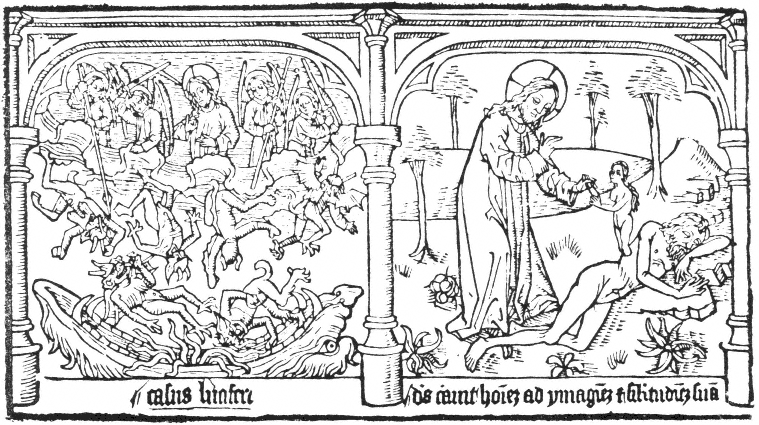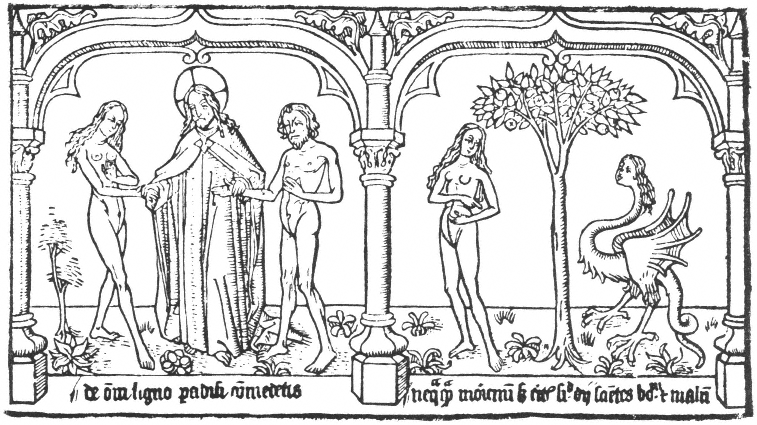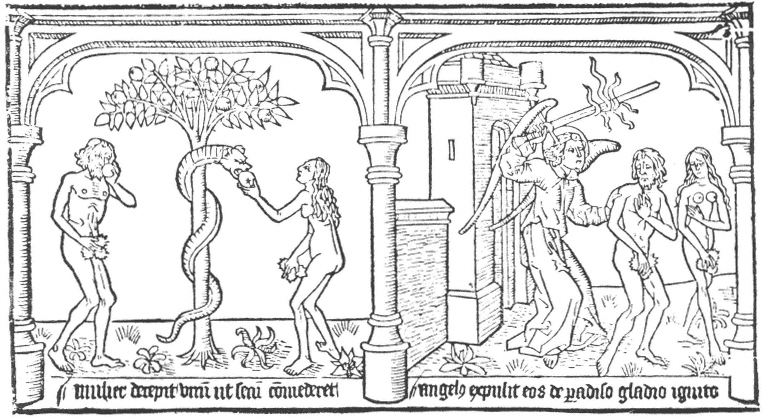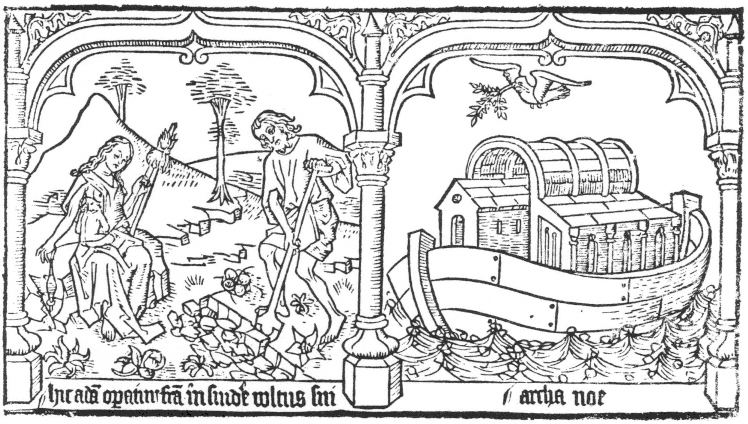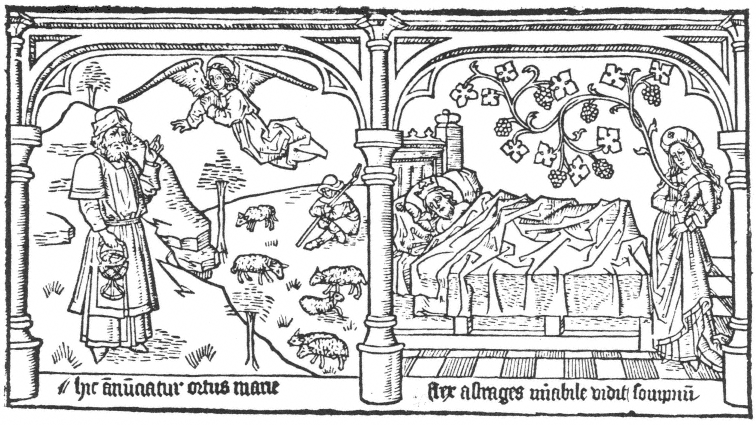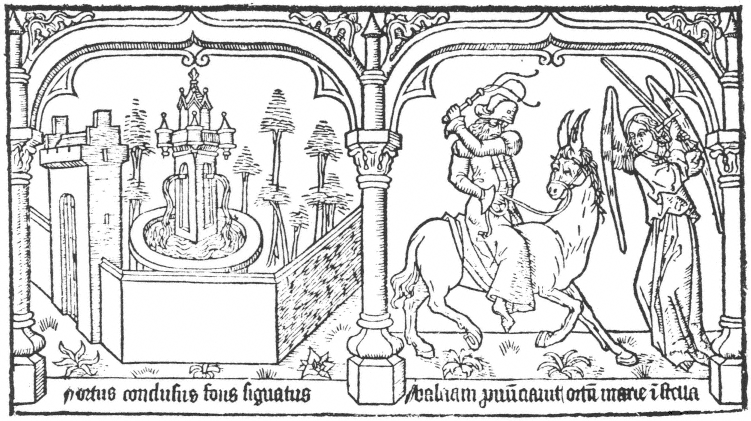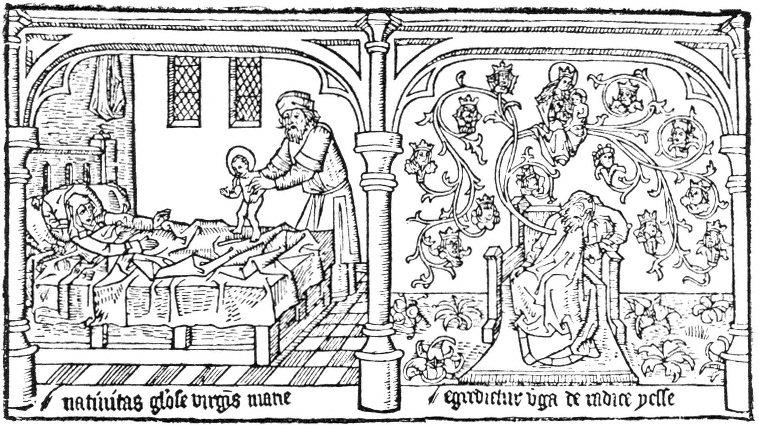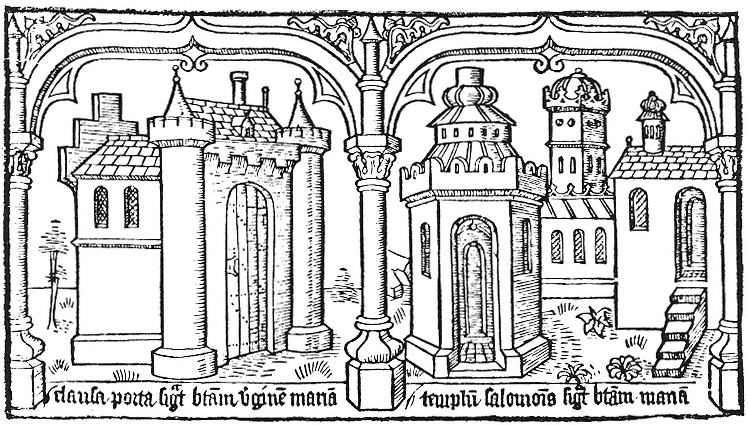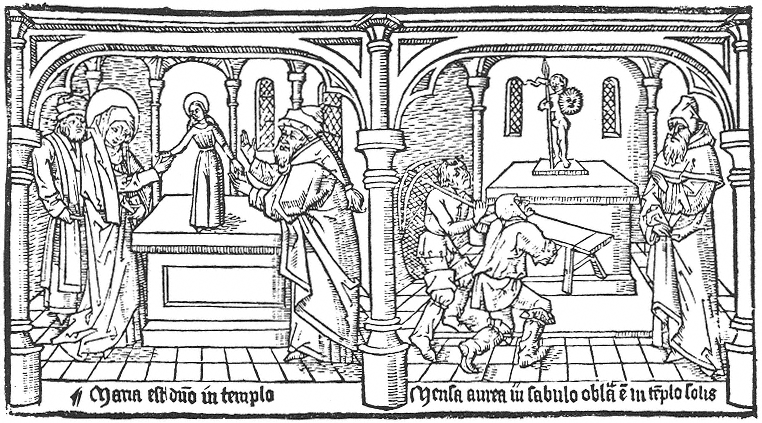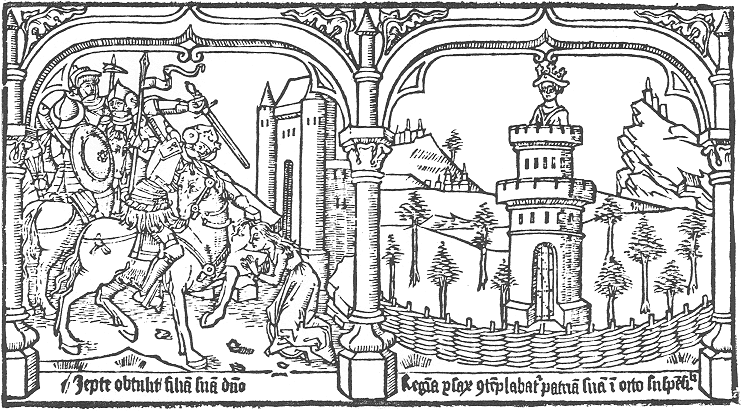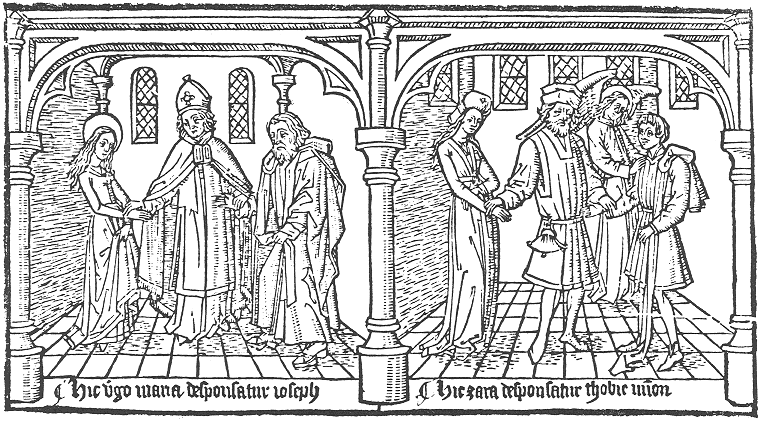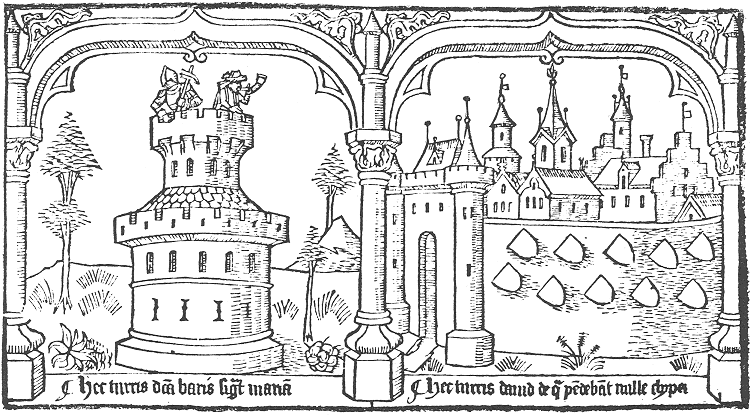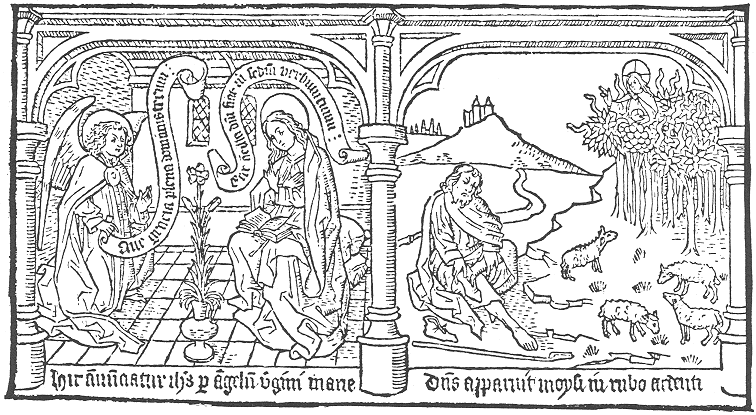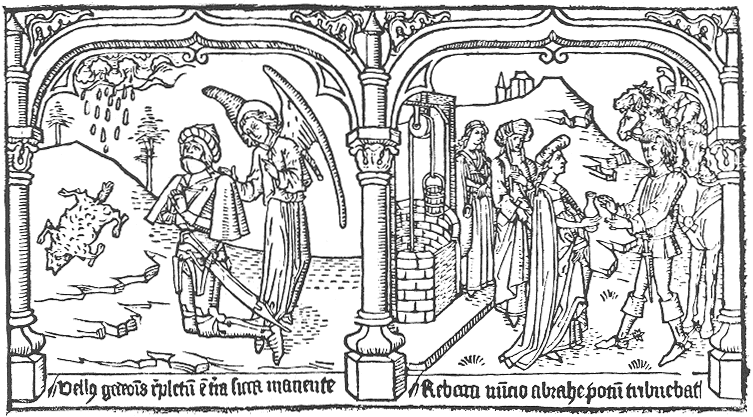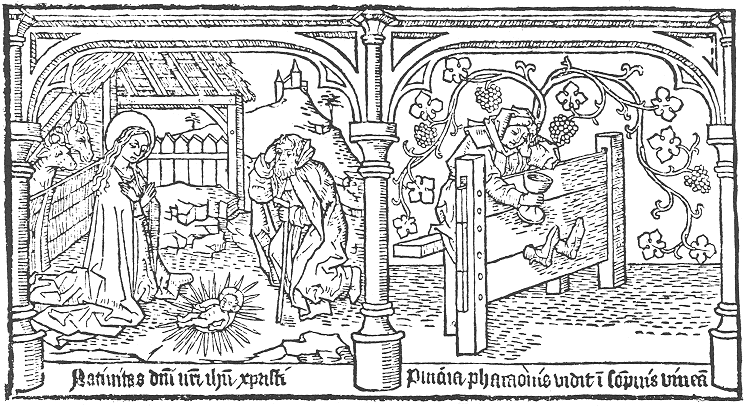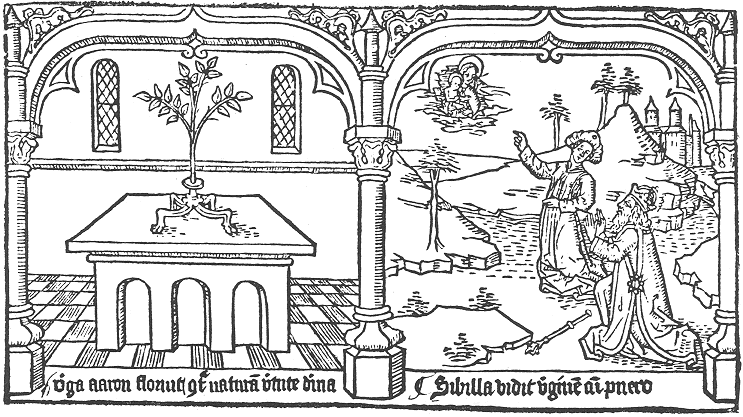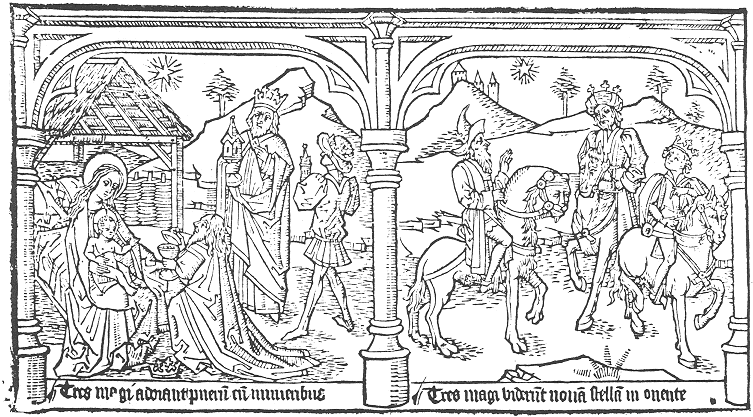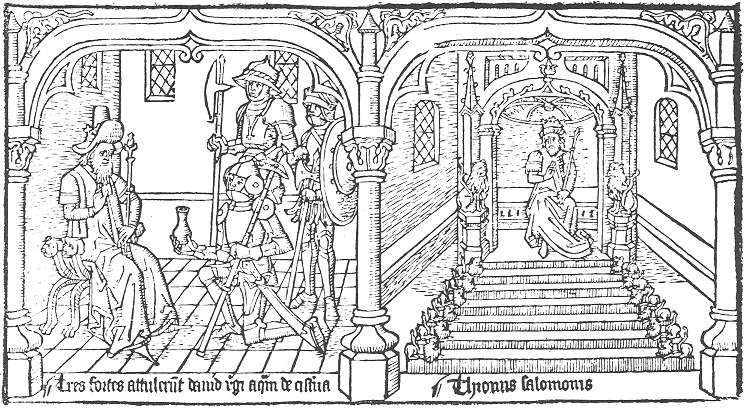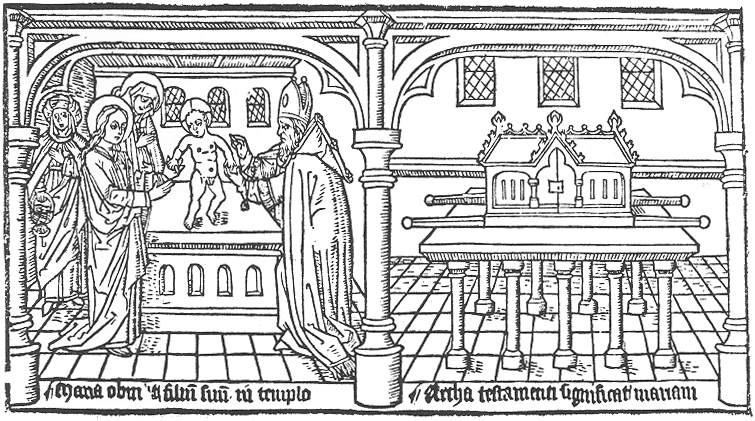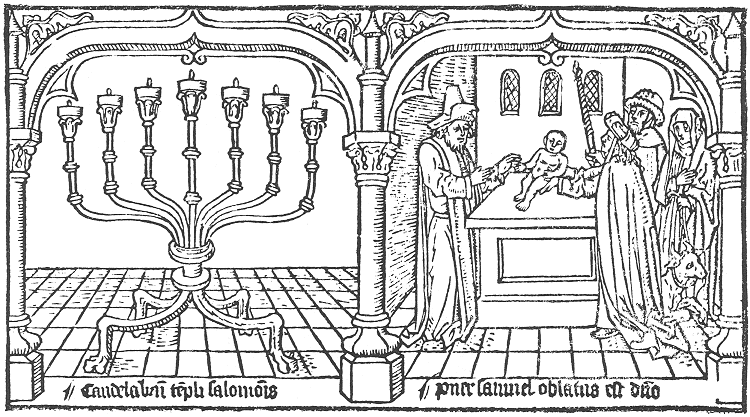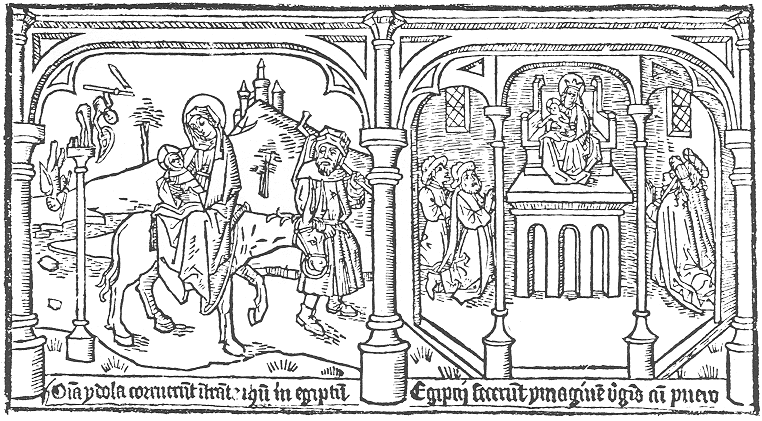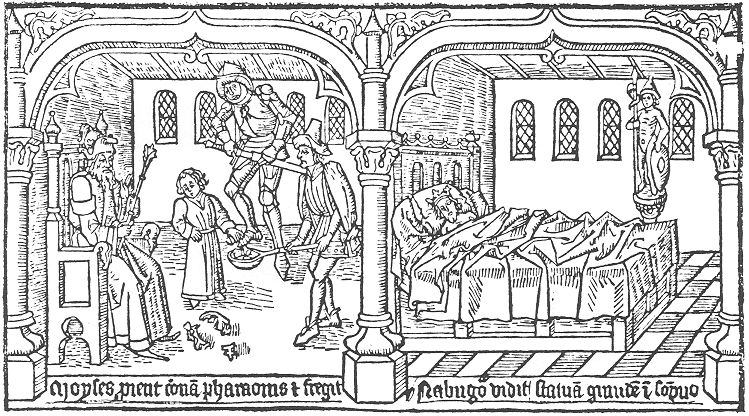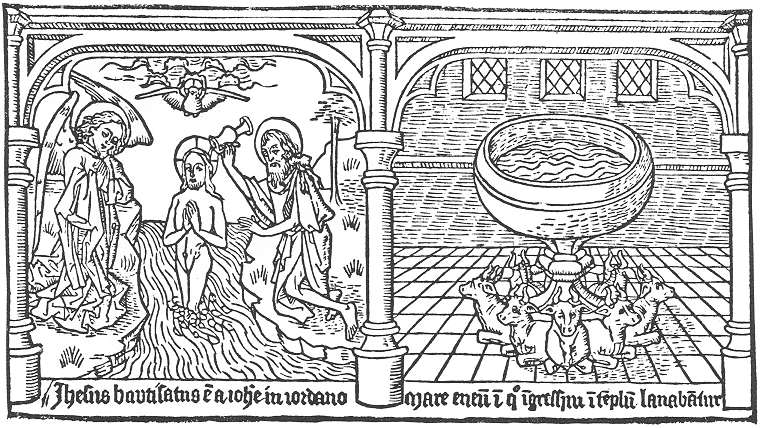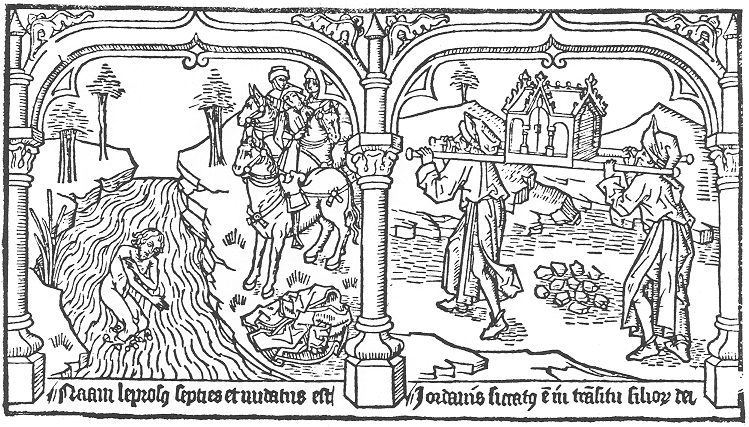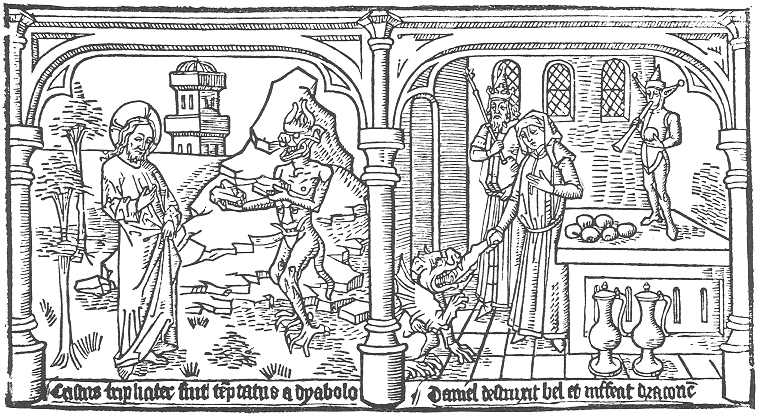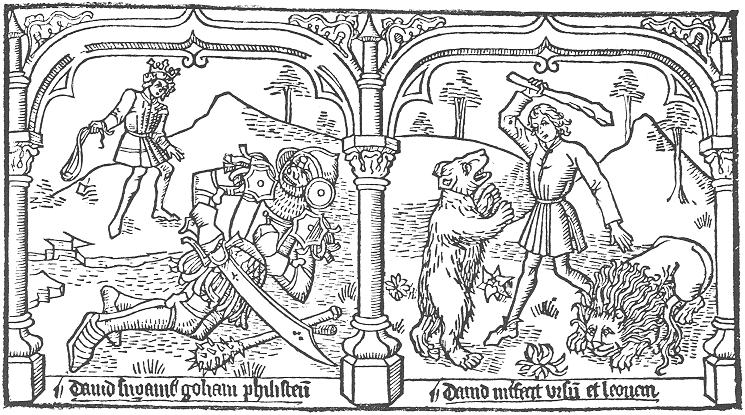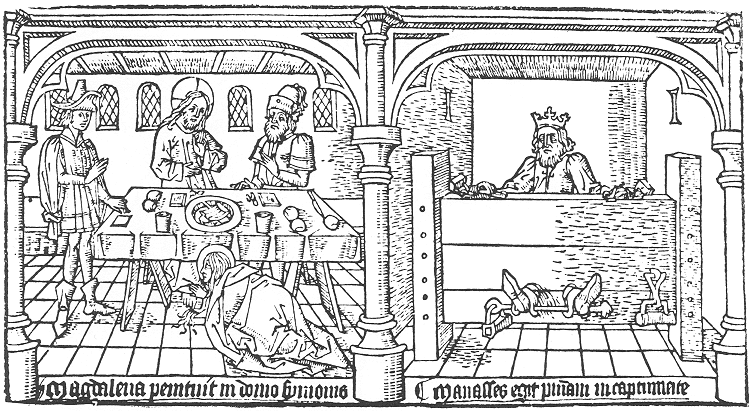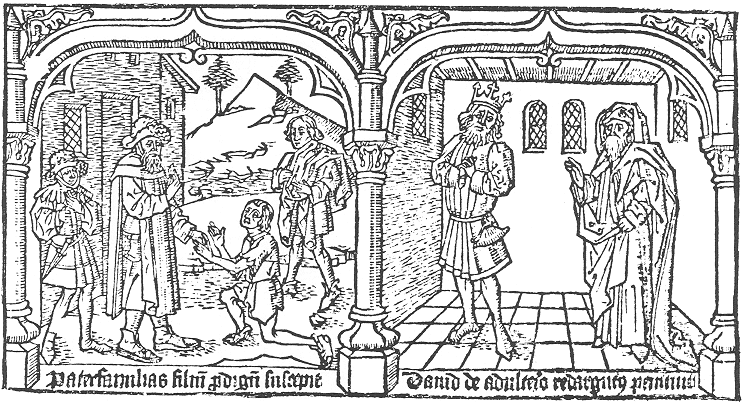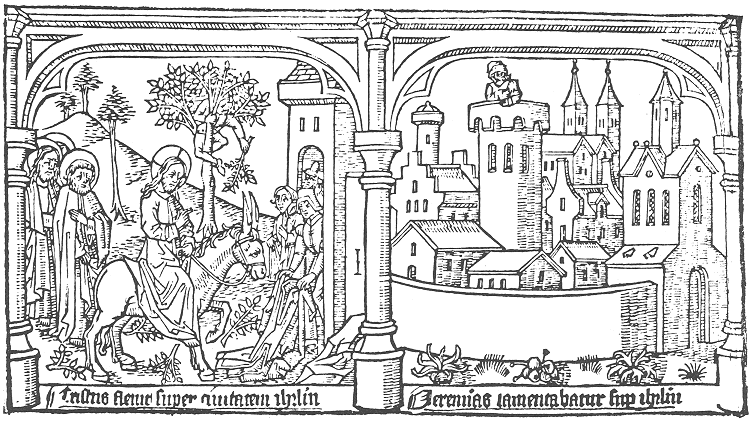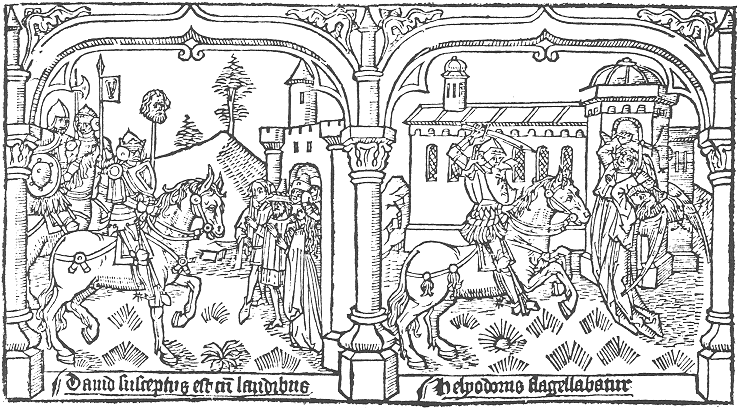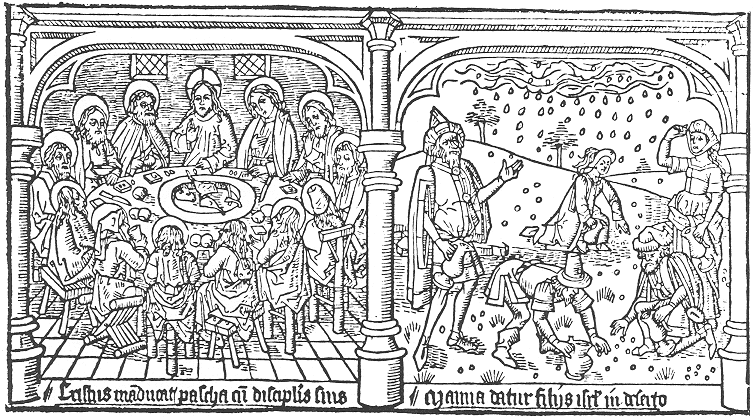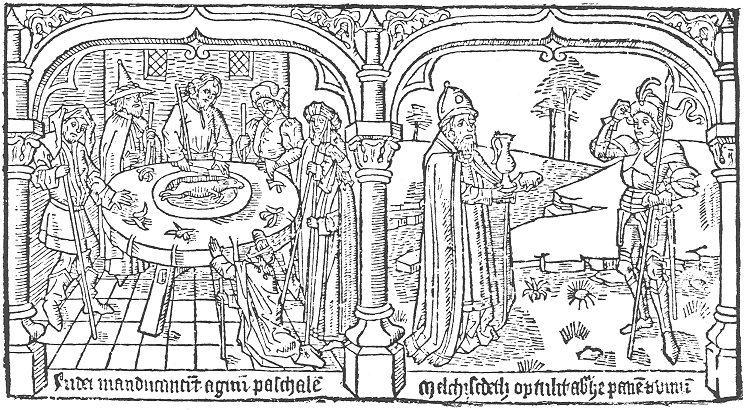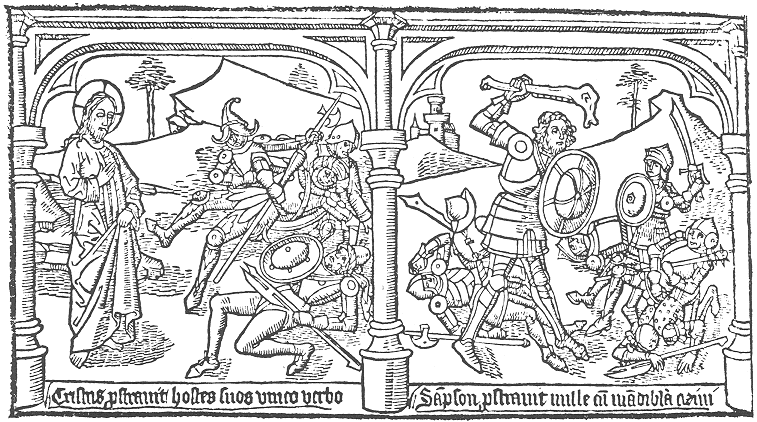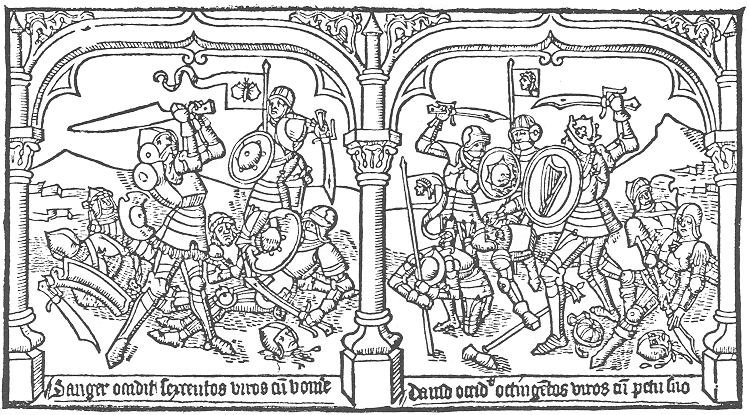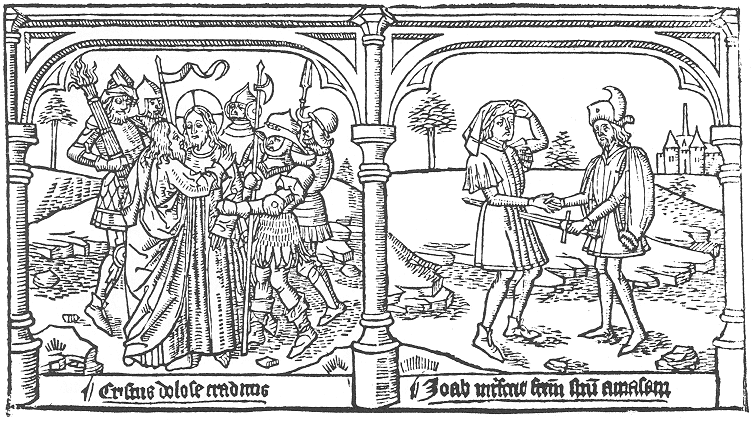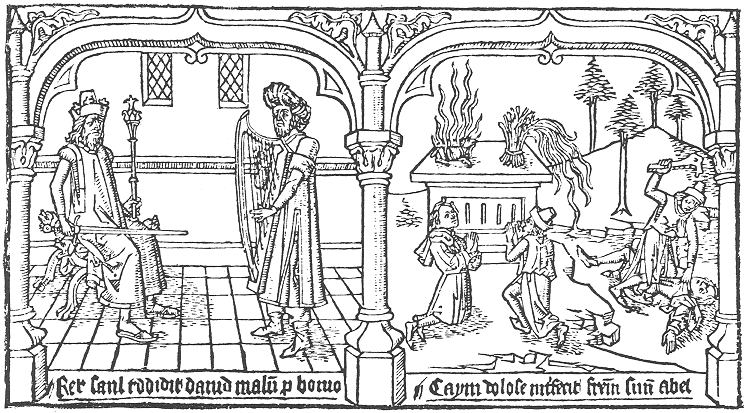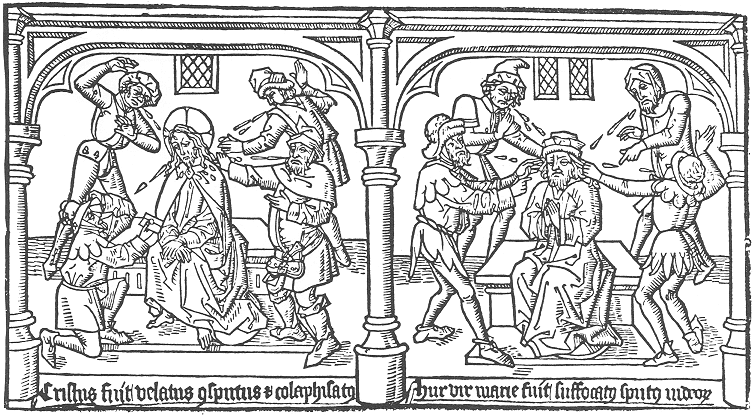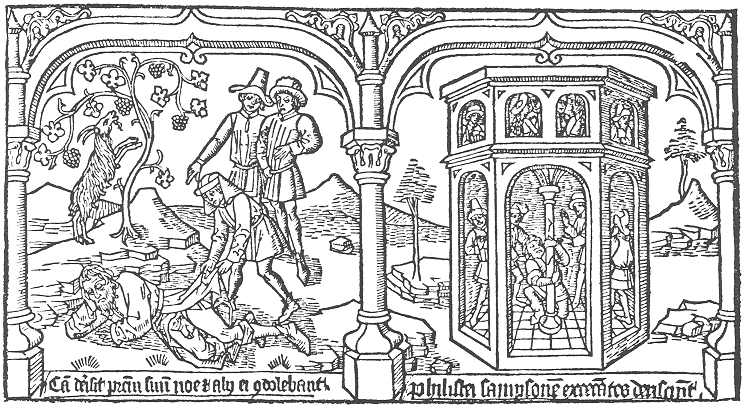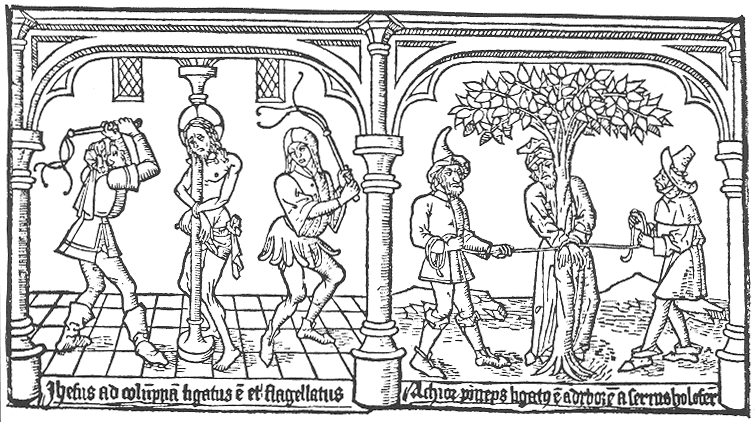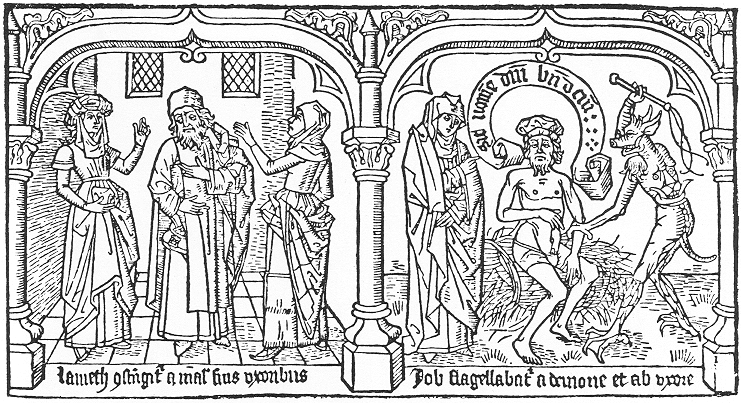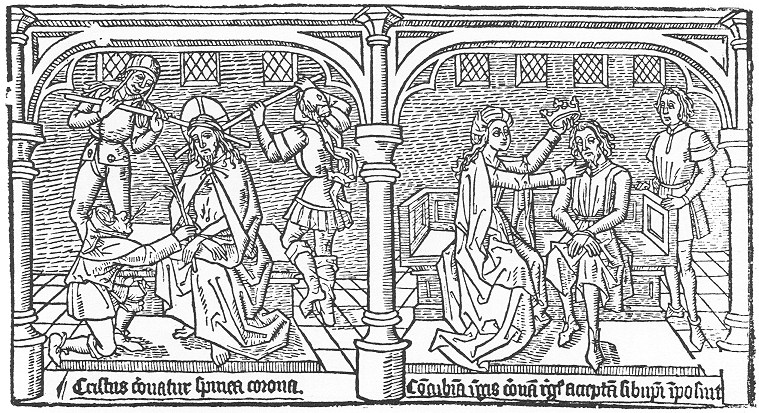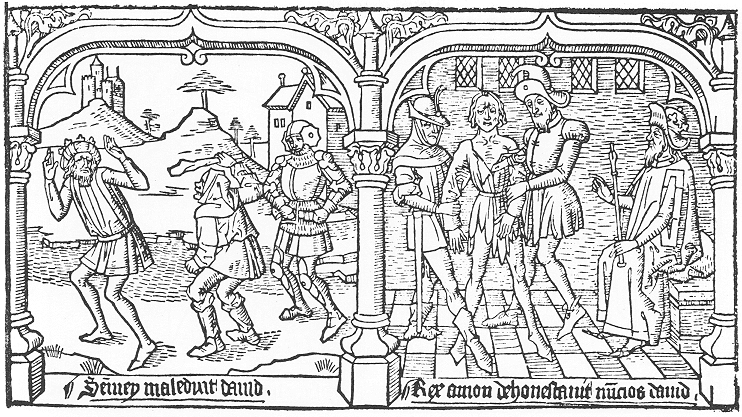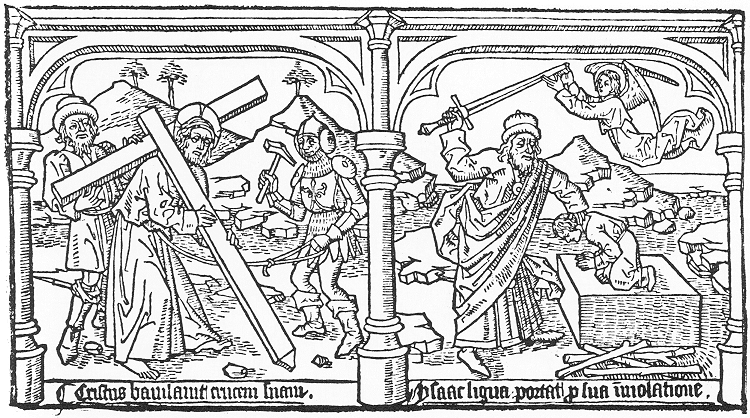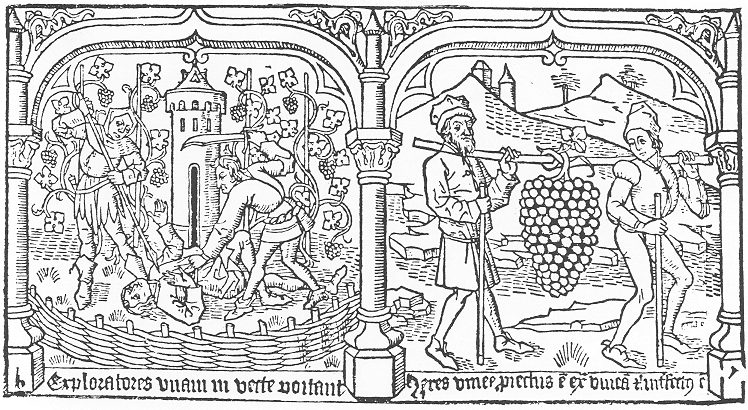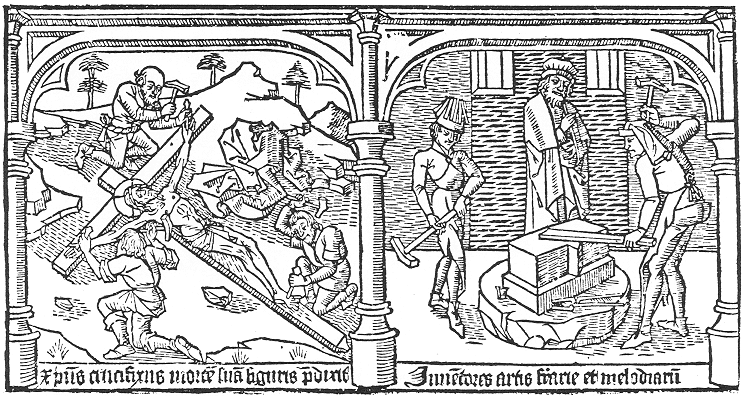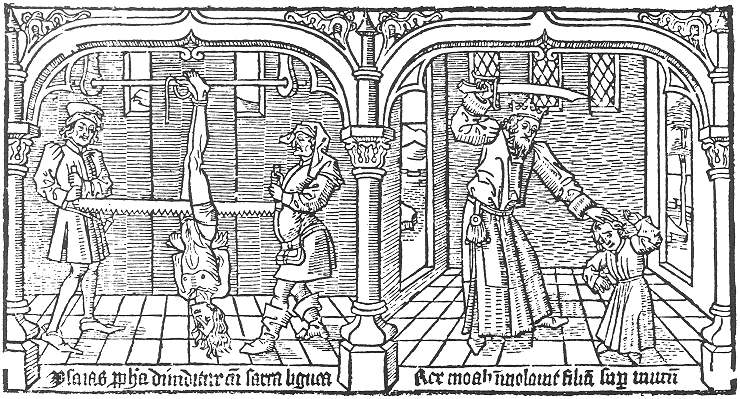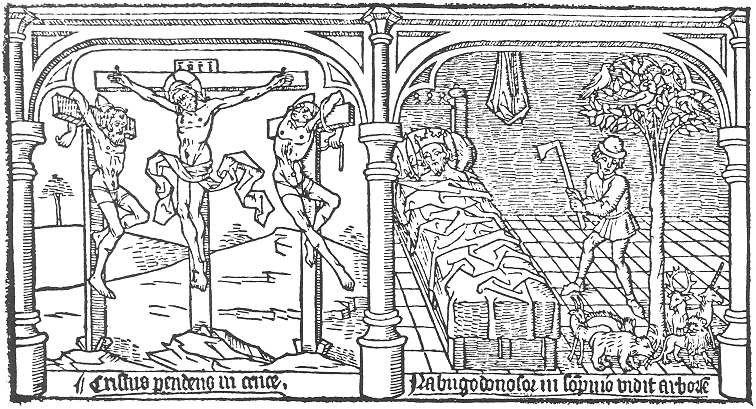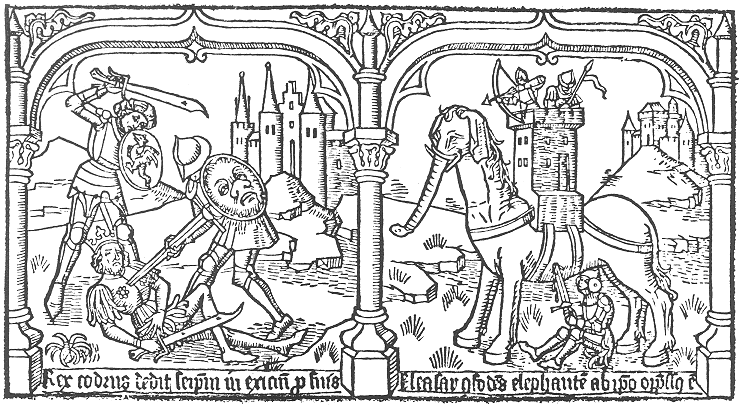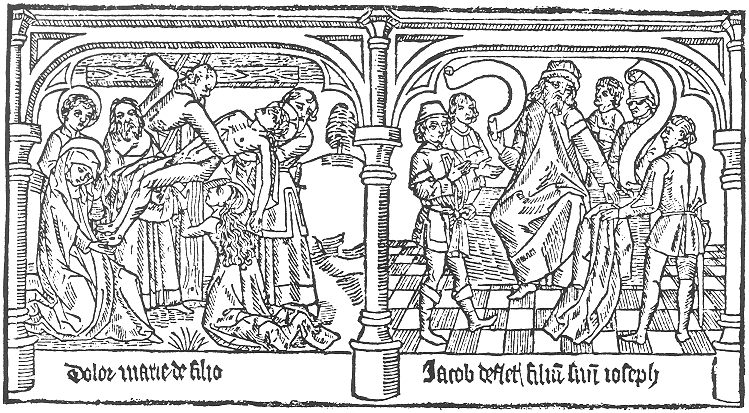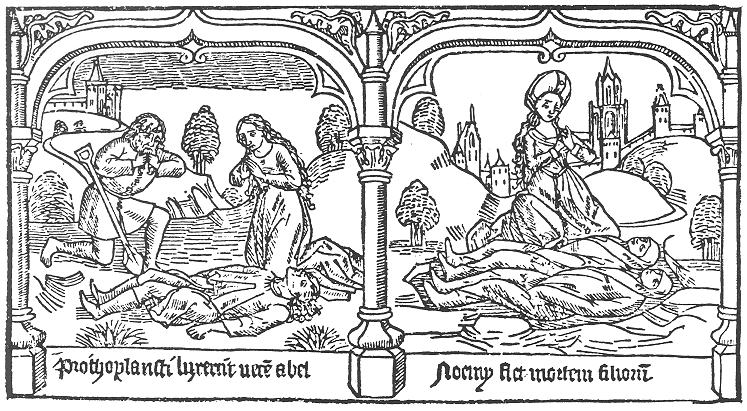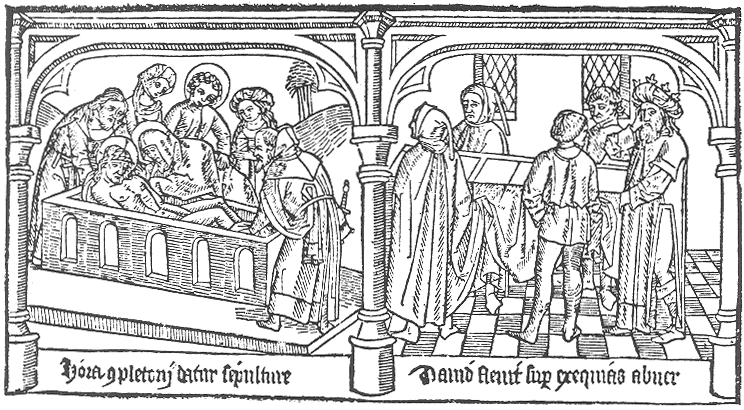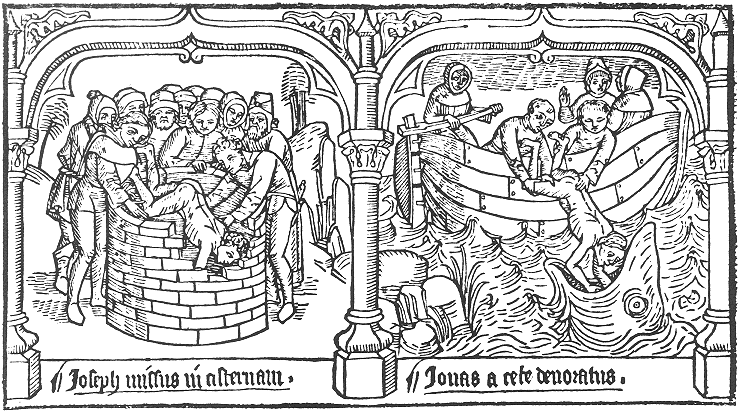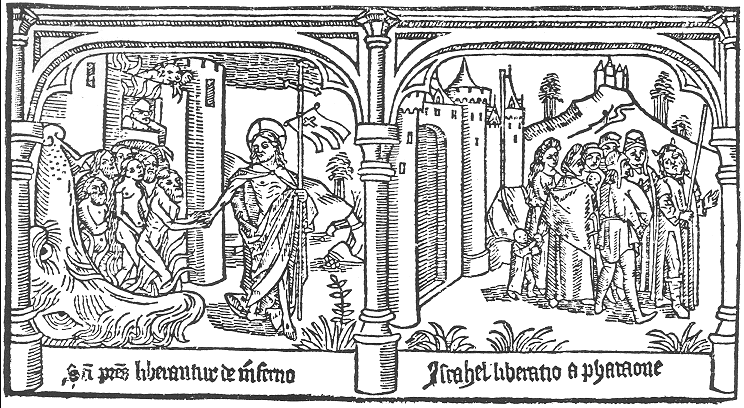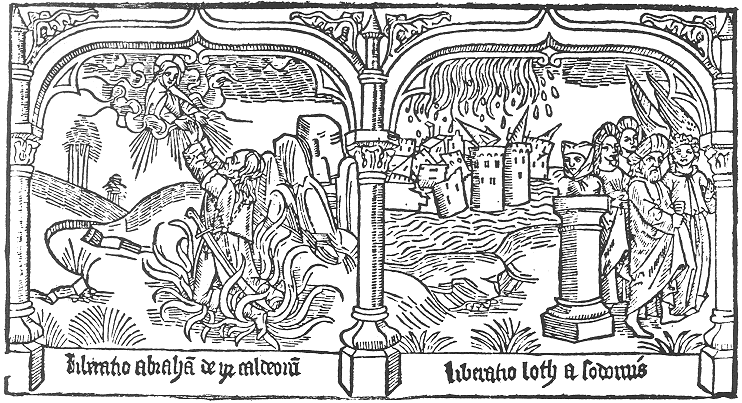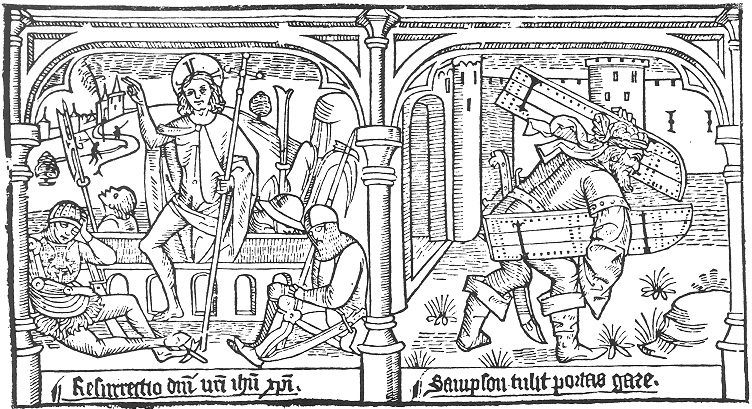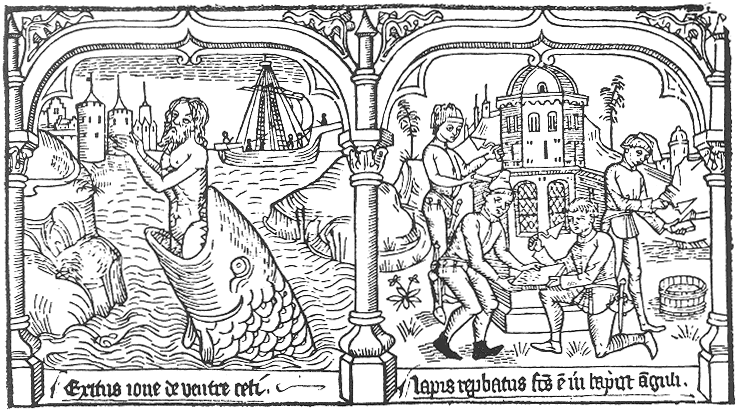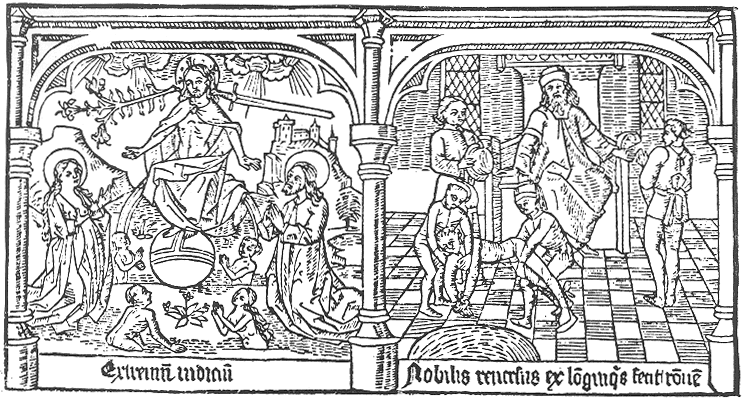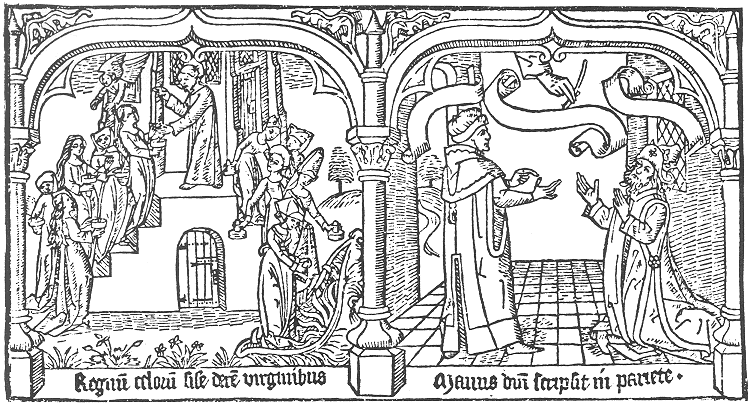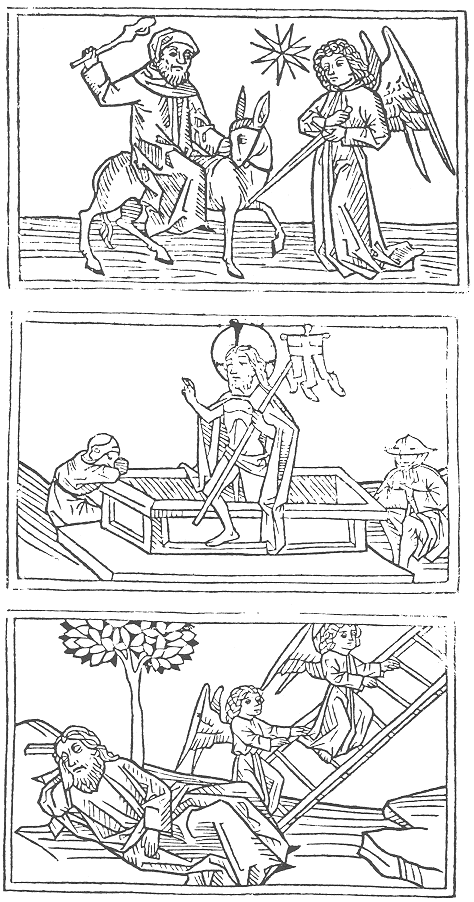VI—
Speculum Woodcuts and Miniatures
At the head of each page of the Speculum is a woodcut containing two scenes with captions below, in Latin, often heavily contracted. In the following descriptions these have been spelled out and a translation given. The biblical or other source reference for the text appears usually at the foot of the column and is occasionally erroneous or sometimes missing altogether. In a few cases a reference is made to the Legenda aurea , the Historia scholastica , or some other medieval text. Parenthetical references are to the Douay-Rheims version of the Vulgate.
The text of the Speculum is not always concerned with the explanation of the illustration but is often devoted to the significance of the prefiguration. Certain events are thus distorted at the expense of the biblical or legendary accounts to serve the typological concept.
From Chapters I through XXIV the subjects follow the manuscripts of the Speculum . After this, only manuscript chapters XXVI, XXVII, XXXI, XXXII, and XL are included in the twenty-nine chapter blockbook editions.
Chapter I
a. Casus Luciferi
(The Fall of Lucifer)
God, shown throughout this chapter as Jesus Christ, is surrounded by the blessed angels in Heaven. Below is the scene of the Fall of Lucifer and his followers into the gaping mouth of the Leviathan ![]() , of the book of Job XLI, which is commonly identified with the inferno. The fallen angels are represented with wings, horns and cocks' feet. The Fall of the Angels is first found in Judeo-Greek literature of Alexandria in the two centuries before Christ.
, of the book of Job XLI, which is commonly identified with the inferno. The fallen angels are represented with wings, horns and cocks' feet. The Fall of the Angels is first found in Judeo-Greek literature of Alexandria in the two centuries before Christ.
Revelation XII, 7–9
(Apocalypse)
b. Deus creavit hominem ad ymaginem et similitudinem suam
(God created man in his own image and likeness)
In the medieval concept, Adam and Eve are at the origin of Redemption, for without their sin no redemption would be necessary. In the typological concept Adam prefigures Christ, and Eve, Mary. In addition, Eve emerging from the side of Adam was the symbol of the Church coming from the body of Christ.
Genesis II, 22
c. De omni ligno paradisi commedetis
(Of all the trees of paradise you may freely eat)
The scene shows the marriage of Adam and Eve, which is described in the text (Eve was given to Adam in marriage by the command of God), as found in Genesis II, 22–25. The verse of the caption referring to the trees is irrelevant to the text and comes from Genesis II, 16. In many manuscripts the caption is copulatio ade et eve , to relate to the marriage sacrament.
d. Nequaquam moriemini sed eritis simultudine domini scientes bonum et malum
(Surely you will not die but you will be like God knowing good and evil)
Satan is portrayed here in the form of a basilisk to tempt Eve. This legendary winged creature had a human head and eagle feet, and was believed to poison fruit trees with its breath. The caption records Satan's words to Eve.
Genesis III, 4–5
Chapter II
a. Mulier decepit virum ut secum commederet
(The woman beguiled the man to eat with her)
The serpent has become a snake with a dog's head and Eve has given Adam the fruit, which he is eating. Then the eyes of both of them were opened and they knew they were naked. According to the Bible story they sewed some fig leaves into aprons. Eve is shown taking an apple from the serpent's mouth.
Genesis III, 6–7
b. Angelus expulit eos de paradiso gladio ignito
(The angel expelled them from paradise with a burning sword)
The Garden of Eden is enclosed with a heavy wall and a portal. The Genesis story does not include the angel but he is mentioned in the text of the Speculum , "holding the sword of justice." The Bible states that God drove out the man and woman and placed cherubims at the east of the Garden and a flaming sword which turned.
Genesis III, 24
c. Hic Adam operatur terram in sudore vultus sui
(Here Adam tills the soil in the sweat of his brow)
The concept of Eve spinning is drawn from a medieval tradition of unknown origin, but the Bible story includes the Lord God driving Adam out of Paradise to till the earth from which he was taken. The Speculum text tells both of Adam tilling and Eve spinning.
Genesis III, 23
d. Archa Noe
(The Ark of Noah)
The Deluge was considered to be God's punishment for man's wickedness, and in medieval historiography it marked the end of the First Age. The ark is shown without rudder or oars, in order for it to float freely. It is of typically fifteenth-century Dutch construction, but the superstructure with its vaulted nave suggesting a reference to the ark as the Church was a well-known equation in the Middle Ages.
Genesis VIII, 10–11
Chapter III
a. Hic annunciatur ortus Marie
(Here is announced the birth of Mary)
The annunciation by the angel who appeared to Joachim to foretell the birth of the Virgin Mary does not appear in the Gospels, but it is treated here as a New Testament event, prefigured in the following three typologies. The story is drawn from the Legenda aurea .
b. Rex Astyages mirabile vidit sompnium
(King Astyages had a marvelous dream)
The King dreamt that from the breast of his daughter a verdant and fruitful vine grew, signifying that her offspring, King Cyrus, would deliver the children of Israel from captivity. This prefigured that the daughter of Joachim and Anna would bear the child, Jesus, who would redeem mankind. The story is from the Historia scholastica of Petrus Comestor.
c. Ortus conclusus fons signatus
(The enclosed garden and sealed fountain)
Drawn from the Song of Songs, these symbols prefigure the virginity of Mary. The Middle Ages saw the Bride, in the biblical verses, as the Virgin Mary. St. Bernard applied all of its metaphors to her; she was the Burning Bush, the Ark of the Covenant, the Fleece of Gideon.
Song of Solomon IV, 12, 15
(Canticle of Canticles)
d. Balaam pronunciavit ortum marie in stella
(Balaam prophesied the birth of Mary in a star)
Balaam beat his ass with a whip of three cords when it turned away from the path on seeing the angel with a sword. As the text of the Speculum and the inscription state, Balaam saw a star and then prophesied the birth of the Virgin Mary. The prefiguration is that of Balaam's prophecy but the artist has omitted the star from the picture.
Numbers XXII, 22–34
Chapter IV
a. Nativitas gloriose virginis Marie
(The glorious birth of the Virgin Mary)
The scene shows Joachim presenting the nude infant Mary, with a nimbus, to his wife Anna, in a fifteenth-century Netherlandish bedroom. He is dressed exactly as in Chapter III. This scene is not described in the Gospels but is drawn from the Legenda aurea .
b. Egredietur virga de radice Yesse
(The branch rises out of the root of Jesse)
The symbolic interpretation of the Tree of Jesse as the lineage of kings goes back to the time of St. Jerome, when the verse in Isaiah was combined with the genealogy of Jesus. Toward the end of the Middle Ages it became the Tree of Mary, with the Virgin shown at the top holding the infant in her arms. The seven plants on the ground may refer to the description in the text of the Speculum of seven "good medicines" or Gifts of the Holy Spirit embodied in Jesus, the flower of Jesse's tree.
Isaiah XI, 1; Matthew I, 1–16
(Isaias)
c. Clausa porta significat beatam virginem mariam
(The closed door signifies the blessed Virgin Mary)
Ezekiel saw this gate in a dream and only the Lord had entered through it. It prefigures the virginity of Mary.
Ezekiel XLIV, 1–2
(Ezechiel)
d. Templum Salomonis significat beatam mariam
(The temple of Solomon signifies the blessed Mary)
The three towers surmounting the temples symbolize the triple crown of Mary, that of the virgins, of the martyrs, and of the preachers and doctors.
I Kings VI
(III Kings)
Chapter V
a. Maria (oblata) est domino in templo
(Mary is offered to the Lord in the Temple)
The child Mary is standing on the altar with Anna at her right. She gives one hand to her mother and the other to the priest of the Law. Flemish painters of the period often showed this event as the little Mary climbing the steps of the temple. The story is drawn from the Legenda aurea .
b. Mensa aurea in sabulo oblata est in templo solis
(The golden table in the sand is offered in the temple of the sun)
Here, composed like the preceding woodcut, is an altar in an apse on which stands the statue of the sun god, Apollo. At the right is the priest, at the left the two fishermen who offer the golden table hauled up with their fishnet. This episode originated in a legend of the seven sages of Greece, which was read in the Middle Ages in Valerius Maximus and retold by Plutarch.
c. Jepte obtulit filiam suam domino
(Jephtha sacrificed his daughter to God)
Jephtha had made a vow to the Lord that if the Ammonites were delivered into his hands, he would offer as a sacrifice the first person who came out of his house to greet him on his return from the battle. It was his virgin daughter who did so, and this prefigures the dedication of Mary's virginity to God.
Judges XI, 30–39
d. Regina persarum contemplabatur patriam suam in orto suspensili
(The Queen of Persia contemplated her land in a hanging garden)
The inscription has erroneously assigned to Semiramis the country of Persia instead of Babylon, and she is shown not in the hanging gardens, but in a tower in which the queen was said to have been shut up. The subject prefigures Mary, who spent her time in the temple contemplating the realm of the divine. The scene is from the Historia scholastica .
Chapter VI
a. Hic virgo maria desponsatur joseph
(Here the Virgin Mary is married to Joseph)
In the same apse as in Chapter V a and b, the marriage of Mary and Joseph is shown. The Bishop in the center, wearing a mitre, holds their right hands. The other scenes of marriage in the Speculum are identically composed.
Matthew I, 18
b. Hic zara desponsatur thobie juniori
(Here Sara is married to young Tobit)
Ragyel, the father of Sara, takes her hand and gives it to Tobit with the words, "I give her to you, as says the Law and the decision written in the book of Moses . . . " The angel leans over Tobit to protect him, for the seven previous husbands of Sara died before the wedding night. As a result, Sara had remained chaste, as did the Virgin Mary. The scene is from the Apocrypha.
Tobit VII, 13
(Tobias)
c. Hec turris dicta baris significat mariam
(The tower called Baris signifies Mary)
On top of the tower are two soldiers on guard, one wearing armor, the other blowing a horn. The tower of Baris prefigured, by its impenetrable character, the virginity of Mary. The legend comes from the Historia scholastica .
d. Hec turris david de qua pendebant mille clypei
(The tower of David from which hung a thousand shields)
Only ten shields suffice to represent the thousand, described in the text of the Speculum as references to the thousand protecting virtues of the Virgin. The verse from the Song of Songs was accepted in the Middle Ages as a description of the virginity of Mary, "Thy neck is like the tower of David builded for an armory, whereon there hang a thousand bucklers, all shields of mighty men."
Song of Solomon IV, 4
(Canticle of Canticles)
Chapter VII
a. Hic annunciatur ihesus per angelum virgini marie
(The annunciation of Jesus by the angel to the Virgin Mary)
The scene is portrayed in an interior as was commonplace in Flemish art of the fifteenth century. The banderoles read "Ave gracia plena dominus tecum" (Hail, full of grace, God is with you), and "Ecce ancilla domini fiat mihi secundum verbum tuum" (Behold the handmaiden of the Lord: be it unto me according to thy word).
Luke I, 28, 38
b. Dominus apparauit moysi in rubo ardenti
(God appeared to Moses in the burning bush)
As Moses tends the sheep of Jethro, God the Father appears amidst the flames of a bush which is not being consumed by the fire. The Bible states that God called out to Moses and told him to remove his shoes for he was on holy ground. The unconsumed bush prefigures Mary conceiving without losing her virginity, and also God descending to earth to deliver humanity from damnation. God, as elsewhere in the Speculum , appears in the form of Christ.
Exodus III, 2–5
c. Vellus gedeonis repletus est terra sicca manente
(Gideon's fleece is soaked while the earth remains dry)
Gideon stretched out the fleece on the ground, stating that if the dew fell on it and the soil around it remained dry, then he would know that Israel would be delivered by his hand, as God had promised. The drops of dew descend from the clouds like giant hail. The scene conforms to the iconography of Gideon established in the eleventh century, and the fleece was a frequent prefiguration of the virginity of Mary.
Judges VI, 37
d. Rebecca nuncio abrahe potum tribuebat
(Rebecca gave drink to the servant of Abraham)
Abraham's servant, Eleazer, was sent to find a wife for Isaac and asked the Lord to let this woman be the one who would bring drink for him and his camels. This was Rebecca who by her virginity and compassion prefigured Mary.
Genesis XXIV, 14–19
Chapter VIII
a. Nativitas domini nostri ihesu christi
(The birth of our Lord Jesus Christ)
Christ, surrounded by a radiance, lies on the ground flanked by the kneeling figures of Mary and Joseph. At the left, the ox and ass observe from their stall.
Luke II, 7
b. Pincerna pharaonis vidit in sompnis vineam
(Pharaoh's cup bearer saw a vine in a dream)
Pharaoh's cup bearer had offended him and was put in the stocks. He dreamed that a vine was before him, with three branches which budded, blossomed, and bore grapes. He squeezed the grapes into Pharaoh's cup. Joseph interpreted the dream for him, wherein the cup bearer symbolized humanity captive in sin, the vine symbolized Christ who would redeem mankind, and the grape juice prefigured the blood of Christ.
Genesis XL, 9–11
c. Virga aaron floruit contra naturam virtute divina
(The rod of Aaron flowered against nature through divine will)
Aaron's miraculous rod stands on a metal base on the altar and bears leaves. In illuminated manuscripts of the Speculum the feet were shown as roots. The miraculous flowering of the rod is another prefiguration of the Virgin Birth.
Numbers XVII, 10
d. Sibilla vidit virginem cum puero
(The Sibyl saw a Virgin with a child)
In this scene, drawn from the Chronicon pontificum of Martinus Polonus, the Sibyl shows to the emperor the Virgin appearing in a cloud, telling him that at that moment another king, more powerful than he, was born of a virgin. Both the Sibyl and Augustus are kneeling in awe. This event is often shown by early Flemish painters. In Roger van der Weyden's altarpiece of the Nativity, now in Berlin, the Sibyl's annunciation to the Holy Roman Emperor appears in the left wing of the triptych.
Chapter IX
a. Tres magi adorant puerum cum muneribus
(The three Magi, with gifts, adore the child)
In front of the same shed as in Chapter VIII-a, Mary is seated on a large bed. Following a tradition which goes back to the twelfth century, the Magi are Kings of three ages, one young, one middle-aged, and one old. Neither the Book of Matthew nor the text of the Speculum refer to the wise men as kings, but this detail is drawn from Psalm LXXII which tells of the kings bringing tributes and gifts to the Lord. The star which led the Magi to the Child shines in the sky above the shed.
Matthew II, 11
b. Tres magi viderunt novam stellam in oriente
(The three Magi saw the new star in the East)
This event, which preceded the adoration with gifts, is the meeting of the three Magi, rarely shown in the art of the fifteenth century. The oldest wise man, wearing a hat, is riding a camel without a hump; the middle one, on horseback, wears a turban with a crown; and the youngest, also mounted, wears a crown.
Matthew II, 10
c. Tres fortes attulerunt david regi aquam de cisterna
(Three knights brought water from the cistern to King David)
Three brave warriors broke through the army of the Philistines to draw water for King David from the well at the gate of Bethlehem. They prefigure the three Magi with their gifts. This scene was much popularized by the Speculum and appeared in other works of art.
II Samuel XXIII, 15–16
(II Kings)
d. Thronus salomonis
(The throne of Solomon)
The author has drawn the episode from the Bible and augmented it from the Historia scholastica . The Bible verses describe the visit to King Solomon of the Queen of Sheba, who brought gifts from afar, prefiguring the gifts brought to Christ by the Magi. In the Speculum blockbook the artist has entirely omitted the Queen.
I Kings X, 18–20
(III Kings)
Chapter X
a. Maria obtulit filium suum in templo
(Mary presented her son in the temple)
The child Jesus is standing on the altar, held on one side by the priest Simeon and on the other by the Virgin Mary. Simeon wears a bishop's mitre. Behind Mary stands her mother and a follower with the sacrificial offering.
Luke II, 22
b. Archa testamenti significat mariam
(The Ark of the Covenant signifies Mary)
The Ark, in the form of a Gothic reliquary, is on an altar supported by ten columns, an allusion to the Ten Commandments. Twelve columns are dictated in the Scriptures, to refer to the twelve tribes of Israel. Jesus embodies the Law and is present in the Ark, which prefigures Mary containing the spirit of God.
Exodus XXV, 10–28
c. Candelabrum templi Salomonis
(The candelabrum of the temple of Solomon)
The instructions for the making of the candelabrum, which is to be lighted in the temple for the glory of God, are very exact. The candelabrum is honored, in part, because candles are carried in the Feast of the Purification. According to the text of the Speculum , the seven branches signify the seven works of mercy within Mary.
Exodus XXV, 31–37
d. Puer Samuel oblatus est domino
(The boy Samuel is dedicated to the Lord)
Hannah, who had been barren, vowed that if the Lord answered her prayers to bear a man child, she would consecrate him to the Lord for all his life. The presentation of Samuel is another prefiguration of the presentation of Jesus in the temple. A woman behind Hannah brings the calf to be sacrificed on this occasion.
I Samuel I, 24–28
(I Kings)
Chapter XI
a. Omnia ydola corruerunt intrante ihesu in egiptum
(All the idols fell on the entry of Jesus into Egypt)
This legend of the idols that fell from their columns as the Holy Family passed, on the flight into Egypt, is drawn from Petrus Comestor and numerous other apocryphal writings. It is also based upon a prophetic verse in Isaiah which states that the Lord will ascend on a swift cloud into Egypt, and that the idols of the Egyptians will be moved at his presence.
Isaiah XIX, 1; Matthew II, 13–15
(Isaias)
b. Egiptii fecerunt ymaginem virginis cum puero
(The Egyptians made an image of the Virgin with a Child)
In the familiar apse of other chapters, the Egyptians are kneeling, their hands folded in prayer, in front of a statue of the Virgin and Child seated on a throne on the altar. Mary wears a crown and a nimbus. The event comes from the Historia scholastica of Petrus Comestor.
c. Moyses projecit coronam Pharaonis et fregit
(Moses threw down the crown of Pharaoh and broke it)
This legend is drawn from Comestor who gives its source as the Antiquitate judaica of Josephus. At the feet of Pharaoh is the shattered crown which the child Moses had thrown down. A soldier prepares to slay him, but a servant holds out hot coals, and Moses proves his favor with God by putting one in his mouth without flinching or being burned. After destroying the symbol of Egypt's sovereignty, the crown, Moses was saved by divine intervention so that he could eventually lead the Israelites out of captivity. This parallels the destruction of the Egyptian idols by the passage of the child Jesus, who was protected so that he could live to redeem mankind.
d. Nabugodnasur vidit statuam grandem in sompno
(Nebuchadnezzar saw a large statue in a dream)
The king is in a bed, wearing his crown, and dreams of a column on which a young nude soldier stands with his lance and shield. The statue was subsequently destroyed by being hit with a stone which no hand had touched, prefiguring Jesus' destruction of the idols by his presence alone. The untouched stone refers to the virginity of Mary.
Daniel II, 31–34
Chapter XII
a. Jhesus baptisatus est a johanne in jordano
(Jesus is baptised by John in the Jordan)
Jesus is up to his knees in the river with his hands clasped in prayer. The Holy Ghost in the form of a dove flies above him. At his right kneels the angel holding the baptismal robe, and at his left St. John lifts a goblet from which he pours the water on the head of Jesus.
Matthew III, 13–17
b. Mare eneum in quo ingressuri in templum lavabantur
(The brass vessel in which the entrants to the temple are washed)
God commanded Moses to make a laver of brass with feet, to place between the Tabernacle and the altar. The description of the font, with its twelve oxen supporting it, is explicit in the Bible. Symbolically, as the water is composed of many elements, the baptism can be said in many tongues. The oxen represent the twelve tribes of Israel and the apostles, but only seven are shown here.
II Chronicles IV, 2–5
(II Paralipomenon)
c. Naaman leprosus (lavit) septies et nudatus (mundatus) est
(The leper Naaman washed seven times and was cleansed)
As in the woodcut of Christ being baptised, Naaman is in the Jordan up to his knees. His escort waits on the bank where his cloak lies. His healing in the Jordan prefigures the purification by baptism of Christ.
II Kings V, 14
(IV Kings)
d. Jordanus siccatus est in transitu filiorum dei
(The Jordan is dry for the crossing of the children of God)
The priests carrying the Ark of the Covenant cross over the miraculously dry Jordan. The twelve stones on the dry bed signify the twelve tribes of Israel and prefigure the twelve apostles. The Ark in the middle of the Jordan prefigures Jesus baptised in that river.
Joshua III, 13–17; IV, 9
(Josue)
Chapter XIII
a. Cristus tripliciter fuit temptatus a dyabolo
(Christ was tempted by the Devil in three ways)
The Devil, in the form of a monster with bird's feet, challenges Jesus to transform the stones into bread after his forty-day fast. In the background are the temple tower and the mountain where the other two temptations took place.
Matthew IV, 1–10
b. Daniel destruxit bel, et interfecit draconem
(Daniel destroyed Bel and killed the dragon)
The Babylonian idol, Bel, had to be offered forty ewes, twelve measures of flour, and six measures of wine daily. Daniel mixed a concoction and formed it into balls which he threw into the mouth of the dragon. The creature swallowed them and burst. Nebuchadnezzar, in the background left, was a worshipper of Bel, who is shown as a statuette on the altar, with the offerings at his feet and one in his left hand. He is blowing on a horn. Originally Bel was biting a bone, but the tale was interpreted in many forms. Daniel also shattered the idol, and in killing two gluttons he prefigured Christ conquering the temptation of food. The story is taken from the Apocrypha.
Bel and the Dragon, 22–26
Daniel XIV, 21–27
c. David superavit goliam philisteum
(David overcame the Philistine Goliath)
The giant Goliath is dressed in armor and helmet but the fatal stone is buried in his brow. In the background is David with his sling, wearing a crown although he was not yet the king. The scene prefigures Christ conquering the temptation of pride, for Goliath was proud of his strength and stature.
I Samuel, XVII, 48–50
(I Kings)
d. David interfecit ursum et leonem
(David killed a bear and a lion)
David is shown with a raised club in the act of killing the bear and lion who took a ram from the midst of his flock. As the animals acted out of greed, this event prefigures Christ's triumph over avarice.
I Samuel XVII, 34–36
(I Kings)
Chapter XIV
a. Magdalena penituit in domo symonis
(Magdalen repented in Simon's house)
Mary Magdalen washes the feet of Jesus with her tears of penitence and dries them with her hair. Jesus and Simon are seated at the table and an observer stands at the left to balance the composition. The three prefigurations in this chapter all demonstrate penitence and forgiveness.
Luke VII, 37–38
b. Manasses egit penitentiam in captivitate
(Manasseh did penance in captivity)
This king of Judea, shown here in stocks, had built altars to false gods, and the Lord sent the army of the king of Assyria to capture him. They bound him and took him to Babylon as a prisoner. There he repented and prayed to God. The episode was traditionally considered a model of penitence.
II Chronicles XXXIII, 11–12
(II Paralipomenon)
c. Pater familias filium prodigum suscepit
(The father of the family welcomed the prodigal son)
The richly dressed father holds a ring in one hand and greets his penitent younger son with the other. The older brother watches and a servant stands nearby holding new clothing for the prodigal.
Luke XV, 11–22
d. David de adulterio redargutus penituit
(David refuted, repented his adultery)
King David is depicted with his hands folded in prayer, repenting, and Nathan the prophet raises his right hand to express the Lord's pardon.
II Samuel XII, 13
(II Kings)
Chapter XV
a. Cristus flevit super civitatem jherusalem
(Christ wept over the city of Jerusalem)
While Jesus advanced on the ass, weeping, the people spread out their cloaks on the road and strewed the way with olive branches. The rich man, Zacchaeus, climbed the tree to see Jesus passing.
Luke XIX, 2–4, 36–38, 41
b. Jeremias lamentabatur super jherusalem
(Jeremiah lamented over Jerusalem)
Nebuchadnezzar had razed the city by fire and driven all the inhabitants out. Jeremiah is shown in the top of a tower lamenting the abandoned city.
Lamentations I, 1
c. David susceptus est cum laudibus
(David is welcomed with praise)
The events of David's life have been somewhat confused by the artist. Helmeted and crowned, he returns from slaughtering the Philistines, not as a child, but as a knight, wearing suitable fifteenth-century armor and carrying the head of Goliath on his sword. On the standard of one of his soldiers is the harp, his emblem. This prefigures Jesus' entry into Jerusalem and his acclaim by the people.
I Samuel XVIII, 6
(I Kings)
d. Helyodorus flagellabatur
(Heliodorus flagellated)
The text of the Speculum describes the scene in agreement with the story in the Apocrypha, according to which Heliodorus was struck down by an armored rider on horseback and then whipped by two strong men. Here the artist shows what appears to be a battle between the armored rider and the two men represented as angels. Heliodorus himself is omitted. This is a prefiguration of Jesus driving the money lenders from the temple.
II Maccabees III, 26–27
(II Machabees)
Chapter XVI
a. Cristus manducat pascha cum discipulis suis
(Christ eats the Paschal lamb with his disciples)
The scene is of the Last Supper. In the foreground is Judas without a halo and with a money bag over his shoulder. Christ raises his right hand, as if in blessing, over a plate with the dismembered parts of the Paschal lamb. This scene and the three others in this chapter are found, in similar compositions, in the altarpiece by Dirck Bouts at St. Pierre in Louvain (see p. 139).
Mark XIV, 22–23
b. Manna datur filiis israel in deserto
(Manna given to the Children of Israel in the desert)
Five people representing the Children of Israel are gathering manna and filling their jugs. They are wearing the costumes and headdresses of the Netherlands in the fifteenth century. The manna falls like giant hailstones, as does the dew in the picture of Gideon's fleece (p. 155).
Exodus XVI, 12–35
c. Judei manducaverunt agnum paschalem
(The Jews ate the Paschal lamb)
The composition recalls the Last Supper scene with the Paschal lamb on a round plate at the center of a round table. Each figure has a staff in hand, and all wear hats, except the center figure, who prepares to cut the lamb. The Bible says, "And thus shall ye eat it; with your loins girded, your shoes on your feet, and your staff in your hand . . . " The kneeling woman in the foreground is not identified in the Bible or the text of the Speculum .
Exodus XII, 8, 11, 46
d. Melchisedech optulit abrahe panem et vinum
(Melchizedek offered Abraham bread and wine)
Melchizedek, King of Salem, meets Abraham on his return from battle and gives him bread and wine and his blessing. He is wearing a bishop's mitre to accentuate the association with the Eucharist. The event prefigures the Last Supper.
Genesis XIV, 17–18
Chapter XVII
a. Cristus prostravit hostes suos unico verbo
(Christ prostrated his enemies with a single word)
The four soldiers sent to arrest Jesus of Nazareth drew back and fell to the ground at his words, "I am he."
John XVIII, 6
b. Sampson prostravit mille cum mandibula asini
(Samson prostrated a thousand with the jawbone of an ass)
Filled with the power of the Lord, Samson killed a thousand Philistines with the jawbone, out of vengeance for the killing of his wife. This prefigured the divine power of Jesus' words.
Judges XV, 15
c. Sanger occidit sexcentos viros cum vomere
(Sangar killed six hundred men with a ploughshare)
Sangar defied the Philistines and killed six hundred men to deliver Israel from its enemies. The ox goad with which he slew them is here represented as a large sword or knife.
Judges III, 31
d. David occidit octingentos viros cum (im)petu suo
(David killed eight hundred men with his attack)
The author has given David the credit for killing eight hundred Philistines, in error. In the Bible it was Adino the Eznite, but in the Speculum text David "was like the most tender little worm of the wood, who killed eight hundred men at one onset." The scene shows David, crowned and bearing a shield with his harp, defeating a group of soldiers in battle. Compared to the effect of Jesus' words, these prefigurations seem exaggerated.
II Samuel XXIII, 8
(II Kings)
Chapter XVIII
a. Cristus dolose traditus
(Christ grievously betrayed)
Jesus is surrounded by five armored soldiers while Judas kisses him. There is a flaming torch at the left. St. John's account of the arrest of Christ is the only one of the four Gospels which does not mention the kiss.
Matthew XXVI, 47–50; Mark XIV, 45; Luke XXII, 47
b. Joab interfecit fratrem suum amasam
(Joab killed his brother Amasa)
Joab grasps his brother's hand, instead of his chin as in the biblical account, to kiss him, and runs him through with his sword. Joab's kiss and the treacherous murder prefigure the kiss and betrayal of Christ by Judas.
II Samuel XX, 9–10
(II Kings)
c. Rex saul reddidit david malum pro bono
(King Saul rendered to David evil for good)
Saul, out of envy of David, draws his sword (the text calls for a spear) to murder him while he is playing the harp for Saul. But God protects David, who dodges the thrust. This episode, like the others in this chapter, prefigures the betrayal of trust.
I Samuel XVIII, 10–11
(I Kings)
d. Caym dolose interfecit fratrem suum abel
(Cain grievously killed his brother Abel)
The artist has juxtaposed within the same frame the scene of the offerings of Cain and Abel on the altar and the scene of the murder. God's acceptance of Abel's offering is shown by the flames rising toward heaven; those of the rejected offering of Cain descend toward the earth. On the right the jealous Cain kills Abel with the traditional jawbone of an ass.
Genesis IV, 8
Chapter XIX
a. Cristus fuit velatus, consputus et colaphisatus
(Christ was blindfolded, spat at, and beaten)
Jesus is shown seated but not blindfolded, while he is spat upon and beaten. This is traditionally the "first derision"; the text of the Speculum is clear on this (line 42). St. John is the only Evangelist who does not write of it. The second derision is the placing of the Crown of Thorns, which is much more often pictured, as in Chapter XXI. There is no apparent explanation for the man in the left foreground who kneels, touching (lifting?) his hat with his left hand and proffering a letter (?) with his right.
Matthew XXVI, 67
b. Hur vir marie fuit suffocatus sputo Judeorum
(Hur, the husband of Mary, was suffocated by the spit of the Jews)
The story of Hur, who refused to adore the Golden Calf and was suffocated with spittle by the Jews, does not appear in the Bible. It has been taken from the Historia scholastica The composition repeats picture XIX a.
c. Cam derisit patrem suum noem et alii ei condolebant
(Ham derided his father Noah, and others felt pity for him)
Noah, who planted a vineyard and became drunk on the wine, is mocked by one of his sons, who views his nakedness, while the two respectful sons observe at the right. According to the biblical text, these two had entered backwards into the tent in which Noah lay sleeping, in order to cover their father without viewing his nakedness.
Genesis IX, 21–23
d. Philistei sampsonem excecantes deriserunt
(The Philistines mocked the blinded Samson)
Gathered in a polygonal building, the Philistines are making sport of Samson, who grips the central post. This reflects the passage in the Bible, but there, two columns provide the support. Here the post is cracking before the building collapses, killing the "three thousand men and women" within, and Samson himself.
Judges XVI, 21, 27, 30
Chapter XX
a. Jhesus ad columpnam ligatus est et flagellatus
(Jesus is tied to the column and whipped)
Christ, tied to a column at the center of the composition, is flanked by two scourgers who whip him. Each scene of this chapter has the same composition: a central figure between two others, one seen in profile and the other in three-quarter face.
Matthew XXVII, 26; John XIX, 1
b. Achior princeps ligatus est ad (a)rborem a servis holofernis
(PrinceAchior is tied to the tree by Holofernes' servants)
This episode is taken from the Book of Judith in the Apocrypha and parallels the other torments in this chapter. Achior had told Holofernes of the Israelites' God who performed miracles for them. Holofernes protested that Nebuchadnezzar was the god of the earth, and he had Achior taken prisoner.
Judith VI, 10–13
(Judith VI, 7–9)
c. Lamech constringitur (confligitur) a malis suis uxoribus
(Lamech tormented by his bad wives)
This event is drawn from Comestor's Historia scholastica . The Bible account of Lamech and his two wives, Ada and Sella, does not tell of any torment or beating.
Genesis IV, 19
d. Job flagellabatur a demone et ab uxore
(Job was whipped by the Devil and by his wife)
The biblical story states that Satan smote Job with boils from head to feet, and Job sat down among the ashes with a potsherd to scrape himself. Then his wife said to him "Dost thou still continue in thy simplicity? Bless God, and die." But Job's piety was not shaken. The Devil, as a monster with a grimacing face on his back, raises a whip to strike him. Job's faith, in the face of his torment, is expressed by the words written on the banderole, "sit nomen domini benedictum" (Blessed be the name of the Lord).
Job II, 7–9
Chapter XXI
a. Cristus coronatur spinea corona
(Christ is crowned with a crown of thorns)
This is the second derision of Christ. The crown of thorns is being pressed down on his head by the tormentors with two staves. A third tormentor kneels, placing a reed in Jesus' hand while he spits on him. They dressed him in a purple robe and crowned him with thorns, saying "Hail, King of the Jews" and they spat upon him. (See Speculum Chapter XIX.)
Matthew XXVII, 27–30; John XIX, 2–3
b. Concubina ipsius coronam regis acceptam sibi ipsi imposuit
(The concubine took the king's crown and put it on herself)
This event comes from the Historia scholastica . Apeme takes the crown from the king's head with one hand and slaps him with the other. King Darius' wrists are bound to reflect Jesus' hands in XXI a. A figure stands at the right to balance the composition in the same way as the others in this chapter.
c. Semey maledicit david
(Semei curses David)
The Bible story relates that Semei came out of his house and cursed David and threw stones at him. David's soldier, Abisai, drew his sword to cut off Semei's head, but David prevented him. This is a prefiguration of derision.
II Samuel XVI, 5–7
(II Kings)
d. Rex amon dehonestavit nuncios david
(King Ammon dealt dishonestly with the messengers of David)
Two of King Ammon's servants seize the messenger of David. The one at right cuts his clothes with a knife. The Bible states that David's messengers had half their beards shaved and their clothing cut up to the buttocks; again a prefiguration of derision.
II Samuel X, 2–4
(II Kings)
Chapter XXII
a. Cristus baiulavit crucem suam
(Christ bore his cross)
Jesus is bent under the weight of his cross. At the right a soldier holds a rope tied around Christ's waist in his left hand, and a hammer for the nailing to the cross in his right. Simon stands behind Jesus helping to support the cross.
Luke XXIII, 26; John XIX, 17
b. Ysaac ligna portat pro sua immolatione
(Isaac carries the wood for his sacrifice)
The oldest manuscripts of the Speculum show Isaac carrying the wood for his sacrifice on his back, thus paralleling Christ carrying the cross. The artist of the block has chosen the more dramatic moment of the episode, when Isaac kneels on the altar and the Angel stops the sword of Abraham. The wood is stacked beside the altar. There is thus a weakening here of the typological parallel, but the mere presence of certain characters is enough to imply the prefiguration.
Genesis XXII, 6–12
c. Exploratores uvam in vecte portant
(The spies are carrying a cluster of grapes on a pole)
This caption belongs to XXII d and is misplaced, which suggests that the letter-cutter did not cut the picture. The Speculum text here states that the son who inherited the vineyard was killed by greedy servants, in a parable told by Jesus. The vineyard owner had sent his son, as God sent Jesus, and both were put to death. The allegory is drawn from Isidore of Seville.
Matthew XXI, 33–39
d. Heres vinee prectus est extra vineam et interfectus est
(The heir of the vineyard is cast out and killed)
The correct caption is XXII c. The emissaries of Moses in search of fertile lands for the Israelites came to a brook and cut a branch with an enormous bunch of grapes which they carried on their shoulders. Jesus was symbolized by the grapes, of which the juice was the wine of the Eucharist. The bearers symbolize the two peoples who took Jesus out of Jerusalem, the Jews (the one with his back to the grapes) and the Gentiles (following the grapes). The grapes hanging from the branch allude to Christ on the Cross.
Numbers XIII, 24
Chapter XXIII
a. Xpus crucifixus mortem suam figuris predixit
(Christ predicted in figures his own death by crucifixion)
Christ is being nailed to the cross by three kneeling men, one for each hand and one for the feet. In some manuscript versions, a blacksmith is seen forging the nails of the Passion. This may show the influence of the blockbook in which, adjacent to the Crucifixion, the forge of Tubalcain is shown as a prefiguration. The nailing to the cross is not described in the Bible.
b. Inventores artis ferrarie et melodiarum
(The inventors of the arts of smithery and melody)
Tubalcain was the ancestor of all who worked in metal, and Jubal was the father of all those who played the harp and the organ. The Speculum text states that while Tubalcain made sound resonate by hammering in his forge, Jubal made a melody of the sound. This prefigures the prayer of Jesus for his enemies at the moment of his Crucifixion. Here they are shown at work hammering on an anvil. The figure in the center may be their father, Lamech.
Genesis IV, 21–22
c. Ysaias propheta dividitur cum sarra lignea
(The prophet Isaiah is cut in half by a wood-saw)
This legendary account of Isaiah's death is drawn from Petrus Comestor. According to the text of the Speculum , the division of Isaiah into two parts prefigures the separation of Jesus' soul from his body.
d. Rex moab immolavit filium super murum
(King Moab sacrificed his son on the walls)
King Moab is shown with a raised sword about to sacrifice his son in order to save the inhabitants of his city from famine during a siege. Although the biblical and Speculum texts describe the sacrifice of the child on the walls of the city, it takes place here in an interior.
II Kings III, 27
(IV Kings)
Chapter XXIV
a. Cristus pendens in cruce
(Christ hanging on the cross)
Christ on the cross is flanked by the two thieves who are tied to their crosses. In crucifixion scenes by artists north of the Alps, Jesus is shown nailed to his cross as in this woodcut, presumably indicating the cruelty of the Jews.
Matthew XXVII, 35; Mark XV, 25;
Luke XXIII, 33; John XIX, 18
b. Nabugodonosor in sompnio vidit arborem
(Nebuchadnezzar saw a tree in a dream)
Daniel interpreted the dream of Nebuchadnezzar of the great tree whose branches sheltered the birds and shaded the animals until a "holy one" came down from heaven and felled it. The tree represented Nebuchadnezzar's great power which must be humbled in the sight of the Lord. This prefigures the death of Jesus to redeem mankind. Here Nebuchadnezzar sleeps in a bed at the left while a man raises an axe to cut down the tree, with birds in its branches and animals at its foot, prophesying his downfall.
Daniel IV, 7–23
c. Rex codrus dedit seipsum in exicium prosuis
(King Codrus gave himself to his destruction for his people)
Two armored soldiers with shields, one showing a dragon, the other a sun, are killing the king at his own request, for the sake of his people. The story is borrowed from Valerius Maximus. In this scene Codrus wears royal clothes and a crown, but according to the story he had changed his clothing to a servant's attire in order to be killed by the enemies who had declined earlier to kill the king. This prefigures the willing sacrifice of Jesus, who dressed himself in human flesh in order to deliver us from our enemies.
d. Eleazar confodiens elephantem ab ipso oppressus est
(Eleazar stabbing the elephant is crushed by it)
Eleazar is shown beneath an elephant supporting a tower with two armed soldiers, as he runs his sword into its belly. It collapsed and died, crushing Eleazar. The artist obviously had never seen an elephant. The story comes from the Apocrypha, and the event prefigures Christ's sacrifice of his life for others.
I Maccabees VI, 37, 43–46
(I Machabees)
Chapter XXV of the manuscripts is omitted in the blockbooks, and at this point a new artist and/or woodcutter made the blocks. The compositions and the architectural framing, as well as the gestures of the figures, follow those of the first artist, but the form of the trees is rounded and the hatching for shadows is frequently diagonal rather than horizontal. The figures are generally larger in the frame .
Chapter XXV
a. Dolor marie de filio
(Mary's sorrow for her son)
In this representation of the Descent from the Cross, the body of Christ divides the composition diagonally, with Joseph of Arimathea at the head, Mary Magdalen kneeling in the foreground, and the Virgin Mary supported at the left by St. John. One of the Virgin's hands is held to her face in sorrow, the other touches Jesus' foot. The texts of the Gospels do not describe the sorrow of the Virgin, but only the granting of the body, by Pilate, to Joseph of Arimathea, and his wrapping it and placing it in the sarcophagus.
Mark XV, 45–46; Luke XXIII, 53; John XIX, 38–40
b. Jacob deflet filium suum joseph
(Jacob laments his son Joseph)
The jealous brothers of Joseph had cast him into a pit, and spotted his coat with goat's blood to convince their father that he had been killed. Here five of them show the coat to the grieving Jacob who is seated at the center. The banderoles have not been lettered and presumably were to be inscribed later. The text of the Speculum emphasizes the sorrow of Rachel, Joseph's mother, as a parallel to that of Mary. This is not present in the biblical account or in the illustration.
Genesis XXXVII, 31–34
c. Prothoplansti luxerunt necem abel
(The first parents mourned the violent death of Abel)
Drawn from Comestor, who states that Adam and Eve mourned for Abel one hundred years, this event is not described in the Bible. As in the other prefigurations of this chapter, the subject is parental grief. Able is stretched out in the foreground, mourned by the kneeling figures of Adam, who pulls his beard in grief, and Eve, who prays.
d. Noemy flet mortem filiorum
(Naomi bewails the death of her sons)
The widow Naomi kneels in grief for the death of her two sons. They lie side by side in winding sheets on the ground before her. Naomi, wearing a large headdress, clasps her hands in an attitude of prayer. In the background is the silhouette of a fifteenth-century city with its spires, as in the preceding illustration.
Ruth I, 5, 20–21
Chapter XXVI
a. Hora completorii datur sepulture
(At the hour of compline [the body] is given to the sepulchre)
Instead of being placed in a cave hollowed out of the rock, as described in the Bible, the body of Jesus is lowered into a rectangular sarcophagus. Nicodemus and Joseph of Arimathea hold Jesus. Mary and St. John are behind, the former bending over her son. Mary Magdalen and another holy woman are present.
Matthew XXVII, 60; Mark XV, 46;
Luke XXIII, 53; John XIX, 42
b. David flevit super exequias abner
(David wept at Abner's funeral)
Abner was killed by Joab because he had killed Joab's brother Asahel, but he was much loved by King David, who mourned for him. Here the coffin is carried to the left by two monks and two pages while the King follows, mourning.
II Samuel III, 32
(II Kings)
c. Joseph missus in cisternam
(Joseph cast into the well)
Joseph is thrown into the dry well by his jealous brothers because their father, Jacob, loved him most and gave him a coat of many colors. The artist has represented a round well with a brick wall conveniently broken away at the front to show Joseph being pushed in, naked, by his brothers. The event prefigures Christ's Entombment.
Genesis XXXVI, 24
d. Jonas a cete devoratus
(Jonah devoured by the whale)
The boat is in stormy waters and Jonah, pictured like Joseph in the preceding image, is cast naked into the whale's mouth. There he remained praying for three days, prefiguring Jesus in the tomb.
Jonah I, 15; II, 1
(Jonas)
Chapter XXVII
a. Sancti patres liberantur de inferno
(The holy fathers are liberated from Hell)
The holy prophets and patriarchs who are in Hell, through no fault of their own (they lived before the Christian era), are delivered from Limbo to occupy a special section of Heaven. The first two to emerge are Adam and Eve, delivered by Jesus and followed by the other rescued souls. The entrance to Hell is commonly shown as the mouth of a ![]() Leviathan. This is taken from the Historia lombardica .
Leviathan. This is taken from the Historia lombardica .
b. Israhel liberatio a Pharaone
(Israel's liberation from the Pharaoh)
Moses, staff in hand and two little horns on his head, leads the children of Israel out of Egypt, represented by a city gate at the left. The 600,000 of the Bible account are represented by eight people, including two children.
Exodus XII, 37, 51
c. Liberatio abraham de yr caldeorum
(The liberation of Abraham from Ur of the Chaldees)
The story in Genesis is the origin of the legend as told in the Historia scholastica , but the Bible does not tell of the flames in which Abraham is kneeling when God appears in the cloud.
Genesis XV, 7
d. Liberatio loth a sodomis
(The liberation of Lot from Sodom)
Sodom is chastised for its wickedness by "hellfire and brimstone." An angel directs Lot to escape with his wife and two daughters without turning back. But Lot's wife looks back and is turned into a pillar of salt. In the Historia scholastica , Petrus Comestor quotes Josephus' Antiquitate Judaica where the word used is "stele," and the artist has placed the bust of salt on a short column.
Genesis XIX, 15, 17, 24
Chapter XXVIII
a. Resurrectio domini nostri jhesu cristi
(The resurrection of our Lord Jesus Christ)
Jesus steps out of the sarcophagus with a cross standard in one hand, and giving the sign of benediction with the other. The Resurrection is not described by the Evangelists nor found in the Passion plays. All four Evangelists tell, instead, of the holy women coming to the sepulchre and finding the stone rolled back and Jesus gone. Angels appeared to tell them that Christ had risen. The text of the Speculum states that the four guards were as if dead from shock at seeing the miracle.
Matthew XXVIII, 1–3; Mark XVI, 1–8;
Luke XXIV, 1–8; John XX, 1–13
b. Sampson tulit portas gaze
(Samson carried off the gates of Gaza)
Samson is a very large figure with one gate under his arm and the other on his shoulder. His enemies had been lying in wait for him at the gates all night to kill him in the morning. But Samson came in the middle of the night and carried off the gates. This prefigures the strength of Jesus' spirit in breaking out of the tomb among his enemies.
Judges XVI, 3
c. Exitus ione de ventre ceti
(The emergence of Jonah from the whale's stomach)
Jonah prayed inside the belly of the whale, and after three days and nights God spoke to the whale and it vomited Jonah out "upon the dry land." The event is taking place in a body of water bounded by rocky banks. In the background there are city towers and a boat with six figures silhouetted in it. This event is a prefiguration of the resurrection of Christ.
Jonah II, 11
(Jonas)
d. Lapis reprobatus factus est in caput anguli
(The stone rejected is made into the head of the corner)
Jesus said to them "Have you never read in the Scriptures that the stone which the builders rejected, the same is become the head of the corner? By the Lord this has been done; and it is wonderful in our eyes." The parable is illustrated by four masons at work constructing the temple of Jerusalem. According to the text of the Speculum , the building was completed with an irregularly shaped stone that had previously been rejected. This prefigures Jesus resurrected, to become the cornerstone of Christianity.
Matthew XXI, 42; Psalm CXVII, 22–23
Chapter XXIX
a. Extremum judicium
(The Last Judgment)
Christ is seated on a rainbow, his feet resting on a globe, flanked by the figures of the Virgin and John the Baptist who kneel and pray in intercession, the former by showing her breast. Below, four nude figures of the dead emerge from the ground to be judged. From the right side of Jesus' head comes the lily of mercy and from the left the sword of vengeance; his right hand, similarly, is held palm up for the saved and his left palm down for the damned.
Revelation XX, 11–12
(Apocalypse)
b. Nobilis reversus ex longinquis fecit rationem
(The noble returned from afar and made an accounting)
The scene is drawn from the parable of the ten talents, in which the master settles accounts with his servants. The one who buried the money (talents) instead of multiplying it is thrown into "exterior darkness." This prefigures the division of the faithful from the wicked. Before the enthroned master, two of the servants carry a third and prepare to cast him into a hole or well in the left foreground.
Matthew XXV, 19–30; Luke XIX, 13–24
c. Regnum celorum simile decem virginibus
(The kingdom of heaven is like the ten virgins)
Jesus told the parable of the ten virgins, five wise and five foolish, who took their lamps and went to meet the Bridegroom. The foolish virgins took no oil in their lamps, and the wise ones took vessels with oil. At midnight there was a cry "Behold, the Bridegroom cometh." The foolish virgins went off to buy oil, while the Bridegroom came and took the five wise ones into the marriage chamber and shut the door. When the others returned, saying "Lord, Lord, open to us," he answered "I know you not." Christ is shown standing at the top of a stairway receiving the wise virgins who approach from the left; at the right, the foolish virgins, with their empty lamps held upside-down, descend a stair into the jaws of hell. An angel leans out of a window of the church-like edifice at left to help welcome the wise virgins.
Matthew XXV, 1–12
d. Manus domini scripsit in pariete
(The hand of God wrote on the wall)
Daniel interpreted the miraculous handwriting on the wall for the kneeling King Belshazzar, whose father, Nebuchadnezzar, had stolen from the temple in Jerusalem the gold and silver vessels with which he had celebrated a great banquet. Daniel's interpretation is that God has weighed Belshazzar in the balance and found him wanting. The Speculum text is worded Mane thetel phares but the banderoles provided to be filled in by hand are blank. Literally, the words in the Bible "Mene, mene, tekel, upharsin" mean "numbered, weighed, divided," a prefiguration of the Last Judgment.
Daniel V, 5, 17, 25
The sixteen chapters of the full Latin manuscripts which are omitted from the blockbooks are listed below. Since the titles of the illustrations vary from copy to copy we have chosen to use those of The Pierpont Morgan Library, Ms. 766, as listed in the Karl W. Hiersemann Prospectus (Leipzig, 1933), adapted .
Chapter XXV
a. Synagoga derisit Christum regem suum et deum
(The Jews mocked Christ, their king and God)
b. Michol subsannat virum suum david
(Michal despises her husband David)
c. Absalon confossus est tribus lanceis insuper invaditur gladiis
(Absalom was pierced by three lances and two swords)
d. Rex Elvilmoradach secuit corpus patris in trecentas partes
(King Elvilmoradach cut up his father's corpse into three hundred pieces)
Chapter XXVIII
a. Iste est infernus
(This is Hell)
b. Angelus domini refrigeravit tres pueros in igne
(The Angel of the Lord kept the three boys cool in the fire)
c. Angelus domini cibavit danielem in lacu leonum per abacuk
(The Angel of the Lord fed Daniel in the lions' den by Habakkuk)
d. Struthio liberavit pullum suum de vitro per sanguinem vermiculi
(The ostrich freed his young from the glass with the reptile's blood)
Chapter XXIX
a. Christus superavit hostem nostrum diabolum
(Christ conquered our enemy the Devil)
b. Bananias descendit in foueam ad leonem et occidit eum
(Bananias descended into the pit and slew the lion)
c. Sampson fortissimus dilaceravit leonem
(Mighty Samson rent the lion asunder)
d. Aioth perfodit eglon pinguissimum hostem filiorum israel
(Ehud pierced Eglon, the fattest enemy of the Children of Israel)
Chapter XXX
a. Maria superavit hostem nostrum diabolum
(Mary conquered our enemy the Devil)
b. Judith decollavit holofernem hostem filiorum israel
(Judith decapitated Holofernes the enemy of the Children of Israel)
c. Jahel perforavit sisarem per tempora
(Jael pierced Sisera through the temples)
d. Regina thamarys decollavit cyrum regem
(Queen Thamarys decapitated King Cyrus)
Chapter XXXIII
a. Ascensio domini
(The Ascension of the Lord)
b. Jacob in sompnis vidit scalam
(Jacob saw the ladder in a dream)
c. Christus ovem inventam reportat in domum suam
(Christ brings the lost sheep back to its home)
d. Helyas translatus est in paradysum
(Elisha is taken up to paradise)
Chapter XXXIV
a. Spiritus sanctus datur in specie diversarum linguarum
(The Holy Spirit is given in species of diverse languages)
b. Turris babel ubi facta est divisio linguarum
(The tower of Babel where the division of many languages took place)
c. Lex data est in monte syna
(The Law is given on Mount Sinai)
d. Omnia vasa paupercule vidue impleta sunt oleo
(All vessels of the poor widow are filled with oil)
Chapter XXXV
a. Consolacio beate virginis post ascensionem domini
(The consolation of the blessed Virgin after the Lord's Ascension)
b. Anna turbatur pro absencia filii sui sicut et Maria
(Anna is perturbed by the absence of her son as was Mary)
c. Mulier habens dragmas decem perdidit unam et querit eam
(The woman having ten coins loses one and seeks it)
d. Micol uxor david data alteri viro semper in luctu permansit
(Michal, David's wife, having been given to another man, always remained in mourning)
Chapter XXXVI
a. Christus rex celorum assumpsit mariam in celum
(Christ, the King of Heaven, received Mary in Heaven)
b. Rex david duxit archam testamenti in domum suam
(King David brought the Ark of the Covenant into his house)
c. Signum apparuit in celo
(A sign appeared in the sky)
d. Rex salomon posuit matri sue thronum ad dexteram suam
(Solomon placed a throne for his mother at his right)
Chapter XXXVII
a. Maria mediatrix nostra placat iram dei contra nos
(Mary, our mediatrix, appeases God's wrath against us)
b. Abigael placat iram regis david contra nabal stultum
(Abigail appeases King David's wrath against the churlish Nabal)
c. Mulier thecuites placat iram david contra absalonem
(The Tekoah woman appeases David's wrath against Absalom)
d. Mulier sapiens in abela placat iram ioab contra urbem
(A wise woman of Abel appeases Joab's wrath against the city)
Chapter XXXVIII
a. Maria est nostra defensatrix
(Mary is our defender)
b. Tharbis defendit urbem saba ab impugnacione moisi
(Tharbis defended the city of Saba against Moses' attack)
c. Mulier laudabilis in thebes defendit cives suos
(A laudable Theban woman defended her fellow-citizens)
d. Micol defendit david incidiis apparitorum
(Michal defended David from the incursions of the armed servants)
Chapter XXXIX
a. Christus ostendit patri suo vulnera
(Christ showed his wound to his Father)
b. Antipater ostendit julio cesari cicatrices suas
(Antipater showed his scars to Julius Caesar)
c. Mary ostendit filio suo ubera sua et orat pro nobis
(Mary showed her son her breast and speaks for us)
d. Hester orat pro populo suo regem assuerum
(Esther speaks on behalf of her people to King Ahasuerus)
Chapter XL appears in the blockbook editions as Chapter XXIX
Chapter XLI
a. Pene dampnatorum in inferno
(The punishments of the damned in Hell)
b. Sic punivit rex david hostes suos
(Thus King David punished his enemies)
c. Gedeon discerpens derisores suos
(Gideon reviles his mockers)
d. Pharao cum exercitu suo submersus est in mari rubro
(Pharaoh with his army is drowned in the Red Sea)
Chapter XLII
a. Regnum celorum erit retribucio beatorum
(The Kingdom of Heaven shall be the reward of the Blessed)
b. Regina saba, rex salomon
(The Queen of Sheba, King Solomon)
c. Convivium regis assueri
(The feast of King Ahasuerus)
d. Convivium filiorum job
(The feast of Job's sons)
Chapter XLIII
a. Miraculum de passione christi
(The Miracle of Christ's Passion)
b. Hora vespertina
(The Washing of the Feet)
c. Hora completorii
(The Judas Kiss)
d. Hora matutina
(Christ before Caiaphas)
e. Hora prima
(Christ before Pilate)
f. Hora tercia
(The Flagellation)
g. Hora sexta
(Christ Bearing the Cross)
h. Hora nona
(The Crucifixion)
Chapter XLIV
a. Miraculum de dolore christi et sue gloriose matris
(Miracle of the sorrows of Christ and his glorious mother).
b. Prima tristitia beate virginis
(First sorrow of the blessed Virgin). The prophecy of a sword piercing Mary's soul.
c. Secunda trisitia beate virginis
(Second sorrow of the blessed Virgin). The flight into Egypt.
d. Tertia tristitia beate virginis
(Third sorrow of the blessed Virgin). Christ in the temple with the learned doctors.
e. Quarta tristitia beate virginis
(Fourth sorrow of the blessed Virgin). The Capture of Christ.
f. Quinta tristitia beate virginis
(Fifth sorrow of the blessed Virgin). The Crucifixion.
g. Sexta tristitia beate virginis
(Sixth sorrow of the blessed Virgin). The Entombment.
h. Septima tristitia beate virginis
(Seventh sorrow of the blessed Virgin). Mary surrounded by the symbols of Christ's life.
Chapter XLV
a. Miraculum de septem gaudiis beate virginis
(Miracle of the seven joys of the blessed Virgin). Mary consoles a sick cleric.
b. Primum gaudium
(First joy). The Annunciation.
c. Secundum gaudium beate virginis
(Second joy). The Visitation.
d. Tertium gaudium beate virginis
(Third joy). The Nativity.
e. Quartum gaudium beate virginis
(Fourth joy). The Adoration.
f. Quintum gaudium beate virginis
(Fifth joy). The Presentation.
g. Sextum gaudium beate virginis
(Sixth joy). Christ in the temple.
h. Septimum gaudium beate virginis
(Seventh joy). The Coronation.
VII-1.
Balaam and the Angel, Chapter III d.
The Resurrection, Chapter XXXII a.
Jacob's Ladder, Chapter XXXIII b.
Speculum humanæ salvationis , Günther Zainer, Augsburg, 1473.
Henry E. Huntington Library and Art Gallery, San Marino, California, 104027.
